Abstract
This paper contributes to recent lines of inquiry addressing the nature of indices in definite expressions. The primary language of investigation is Washo, a North American isolate spoken in the western United States. Building on previous claims about the structure of anaphoric definites, I propose a unified analysis of the Washo DP that lends novel evidence to the claim that indices are best thought of as syntactic objects in their own right, independent from D. The structurally encoded index—introduced by a head idx—is shown to be overtly realized by the morpheme gi/ge in both pronouns and demonstratives, as well as at the periphery of internally headed relative clauses, which are themselves complex DPs. An important aspect of this proposal is the argument that idx can play two related semantic roles: The semantic index it hosts can be interpreted either as a variable, as previously proposed for familiar definites, or itself as a variable binder. The availability of the latter explains the appearance of gi/ge in internally headed relatives. I show moreover that the exponence of idx in Washo is sensitive to the type of complement it takes, a proposal that makes sense of the observed distribution of gi/ge in a range of definite expressions.
Similar content being viewed by others
Avoid common mistakes on your manuscript.
1 Introduction
This paper contributes to recent work on the nature of indices through the investigation of Washo, a North American isolate spoken around Lake Tahoe in the United States. Narrowly, the paper argues for a unified theory of DP structure in Washo according to which structurally-encoded indices are present not only as expected in familiar definites, but also in internally headed relatives, a type of complex DP. More broadly, the paper offers novel morphosyntactic evidence that indices occupy structural positions independent from D (Elbourne 2005; Schwarz 2009), and expands on this work by arguing that the semantic indices hosted on such heads may take on the interpretation of either a variable, as previously proposed, or a variable binder.
The analytical backdrop for this paper is the recent set of claims that DPs give rise to anaphora by virtue of housing indices—interpreted on a par with pronouns—in their structure (Elbourne 2005, 2008; Schwarz 2009; Arkoh and Matthewson 2013; Simonenko 2014; Patel-Grosz and Grosz 2017; Schlenker 2017; Hanink 2018; Jenks 2018). In what follows, I argue that evidence from Washo lends support to an analysis along these lines; Washo wears morphology of this kind on its sleeve in that the proposed structural index in Washo is overtly realized as the morpheme gi/ge.Footnote 1 Evidence for this claim is initially drawn from the distribution of this morpheme in definite expressions, namely third person pronouns (1) and demonstratives (2).Footnote 2
-
(1)
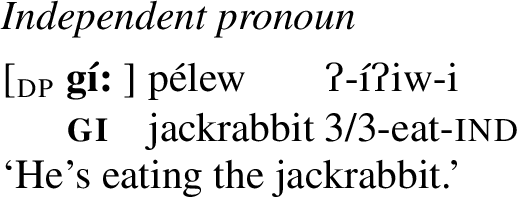
-
(2)
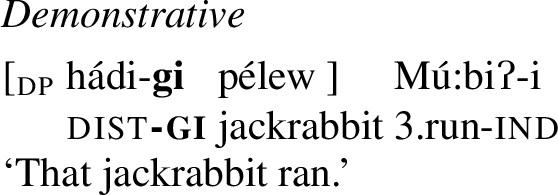
Based on this distribution, I first argue for a unified structure of the Washo DP according to which the morpheme gi/ge is the spell out of an index-encoding head idx within the extended projection of N. The core observation of this paper is then, however, that the same morpheme gi/ge appears as a suffix on the embedded verb within internally headed relative clauses (IHRCs) (3).
-
(3)

I argue that a unified explanation for the presence of gi/ge can be achieved through the claim that, while idx selects for a nominal complement in familiar definites such as pronouns and demonstratives (4), the structure of IHRCs differs only minimally in that idx selects for a clausal complement instead (5).
-
(4)
Familiar definite
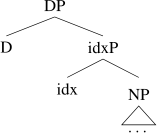
-
(5)
Internally headed relative
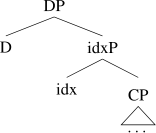
While the appearance of such an index in IHRCs might seem surprising at first glance, I show that the treatment of gi/ge as idx leads to a unified treatment of both familiar DPs and relative clauses of this kind. The core of the proposal contends that idx may play two roles within the DP. On the one hand, the index in DPs such as (4)is interpreted as a variable, contributing a familiar meaning. On the other hand, the index in IHRCs (5) is instead interpreted as a variable binder that serves to bind an open variable inside the proposition-denoting clause it embeds. The proposal that these two meanings are available builds on two advances in the treatment of indices and binding. The first is Heim’s (1998) proposal that there are two types of indices: inner and outer indices, the former a variable, and the latter, a variable binder; the second is the claim that functional heads may act as binders (Kratzer 2009).
After laying out this analysis, I turn to a more detailed discussion of definite descriptions in the language, proposing that pronouns in Washo are best analyzed as definite descriptions in disguise, along the lines of the proposal in Elbourne (2005). Diverging from Elbourne however, I treat Washo gi/ge as an allomorph of idx, rather than of the definite article. Taking the overall distribution of gi/ge into consideration then leads to a rule of contextual allomorphy according to which idx is overtly realized only in case it lacks an overt nominal complement, resulting in a unified analysis of pronouns, demonstratives, anaphoric bare definites, and internally headed relatives, all of which require idx for their interpretation.
In what follows, Sect. 2 provides evidence for the status of dedicated index-hosting heads as syntactic objects. Section 3 gives background on the morphology and internal syntax of internally headed relatives, while Sect. 4 offers an analysis of indices in internally headed relatives according to which they act as binders. Section 5 provides two extensions of the analysis, to: i) the violation of an indefiniteness restriction found in many languages with internally headed relatives (Williamson 1987); and ii) perception readings of clausal nominalizations. Section 6 addresses the exponence of gi/ge within the DP, and Sect. 7 concludes.
2 Indices in DP structure
I begin with a brief review of recent claims that definite descriptions house indices in their structure (Elbourne 2005), highlighting in particular arguments for this view from German (i.a. Schwarz 2009; Simonenko 2014; Hanink 2018). I then offer novel evidence for an analysis along these lines with data from familiar definites in Washo, where I argue that the morpheme gi/ge overtly realizes the proposed head idx in pronouns and demonstratives. This section lays the groundwork for the discussion and analysis of internally headed relatives in Sects. 3 and 4.
2.1 Indices in the German DP
Recent work on anaphora in definite descriptions has engaged much with the nature of indices (Elbourne 2005, 2008; Schwarz 2009; Arkoh and Matthewson 2013; Simonenko 2014; Patel-Grosz and Grosz 2017; Schlenker 2017; Hanink 2018; Jenks 2018). At the core of these proposals is the idea that indices are not represented merely as subscripts on D or N (as in e.g., the Binding Theory of Chomsky 1981; see Fiengo and May 1994 for an overview), but are instead independent objects encoded within the structure of the DP. The presence of an index—interpreted along the lines of a pronoun—is then precisely what gives rise to an anaphoric interpretation.
For example, Schwarz (2009) argues that evidence for the structural presence of indices can be diagnosed by a morphological contrast in German, in which the form of the definite article depends on whether it is anaphoric (or strongly familiar, in the sense of Roberts 2002). Schwarz shows that, on the one hand, the definite article in non-anaphoric contexts contracts with a preceding preposition, as in (6).Footnote 3 The definite in (6) is an instance of a non-anaphoric unique definite in that it has no antecedent, with world knowledge dictating instead that a given town has a unique mayor.Footnote 4
-
(6)

On the other hand, the definite article is barred from contracting in cases where the definite is anaphoric to an antecedent, as in the case of cross-sentential anaphora such as in (7) (Schwarz 2009:40).
-
(7)

To account for this contrast, Schwarz proposes that anaphoric definites contain an index in their structure, to the exclusion of their non-anaphoric counterparts (cf. Elbourne 2005). He argues that, in the case of anaphora, the definite article may not contract with a preposition due to the intervention of this index in its specifier (9). The unique form lacks such an index (8), allowing contraction.
-
(8)
Schwarz’s unique definite

-
(9)
Schwarz’s anaphoric definite
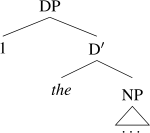
The differences in interpretation moreover are attributed to the following meanings for the definite article, which differ according to whether or not D takes an index (written as ‘1’) as its specifier. The denotation in (10a) for the unique form of the article is a standard Fregean meaning, resulting in (10c).Footnote 5
-
(10)

The strong form differs in that an anaphoric component is built directly into the meaning of D (11), resulting ultimately in a meaning for the DP as (11c).
-
(11)

The index (1) in (11c) is then interpreted essentially as a pronoun, e.g., with the Pronouns and Traces rule from Heim and Kratzer (1998) (12), meaning that it can be mapped back to some antecedent via the assignment function, resulting in an anaphoric interpretation as in, e.g., (7).
-
(12)

In what follows, I largely adopt Schwarz’s distinction between anaphoric and non-anaphoric definites, though I follow the revised implementation of his proposal put forward by Hanink (2017, 2018). On this view, structural indices head their own functional projection, idxP, and host semantic index values as features (where n refers to the set of natural numbers).Footnote 6 As schematized in (13), idx is a phrase-projecting head located in the extended projection of N (in the sense of Grimshaw 2005), on a par with other functional layers present in nominals, e.g., NumP (Ritter 1991, 1993).
-
(13)
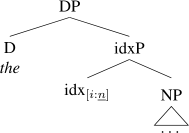
Adopting a suggestion made by Elbourne (2005), Hanink further proposes that the meaning of the index in this structure is property-denoting, on a par with an ident type shift (Partee 1986) of the individual-denoting index (see also Simonenko 2014 on Bavarian). On this view, idx denotes what is essentially the property of being anaphoric, and undergoes Predicate Modification with NP (Heim and Kratzer 1998).
-
(14)

This proposal has the arguable benefit of maintaining a single denotation for the definite article while still obtaining the desired meaning for anaphoric definites, as in (15). While the semantic result is identical, Hanink (2018) differs crucially from Schwarz (2009) in the proposal that the only contribution of D is uniqueness, while idx—selected by D—is solely responsible for introducing an anaphoric meaning.Footnote 7
-
(15)

While I do not go into the details here, Hanink argues that, on this view of the syntax, the morphological difference between anaphoric and non-anaphoric definites can be explained by two distinct, postsyntactic Lowering operations, schematized in (16) (Embick and Noyer 2001:561):
-
(16)

P lowers to D in the general case, resulting in contraction. The presence of idx in anaphoric definites however triggers an additional lowering operation of D to idx (17), bleeding the environment for P-to-D lowering (18) (on a cyclic approach to postsyntactic operations; see e.g., Embick 2010).
-
(17)
D-to-idx Lowering
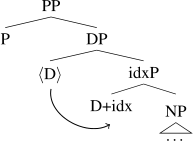
-
(18)
P-to-D Lowering
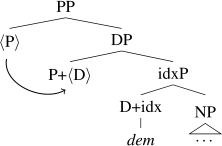
In sum, I have briefly presented in this section previous motivations for positing the presence of idx in anaphoric definites, a proposal that has been shown to account for a range of behaviors in a variety of languages (Akan, Arkoh and Matthewson 2013; ASL, Schlenker 2017; Cantonese, Jenks 2018; see also Schwarz 2013). In the next section, I present arguments for this approach from Washo, an unrelated language that I argue overtly realizes idx in its morphology, rather than covertly as in German.
2.2 Indices in the Washo DP
In this section, I build on Hanink’s (2018) arguments that Washo, like German, encodes indices syntactically within the structure of familiar DPs. Hanink argues that idx is overtly realized in Washo as the morpheme gi/ge, and that this can be observed in the shared morphology of third person pronouns and demonstratives, a type of familiar DP with a deictic component.
It is important to note first that, unlike German, Washo lacks an overt definite article in the general case, and bare nouns may give rise to either an indefinite or definite interpretation.Footnote 8 For example, (19) provides a context where a bare noun receives an indefinite interpretation, introducing a novel referent at the beginning of a story.
-
(19)

The additional possibility for a definite interpretation of a bare noun is shown in (20), in this case with the unique definite ‘the sun.’Footnote 9
-
(20)

Note that, unlike some other article-less languages (e.g., Mandarin, Jenks 2018), Washo does not distinguish morphologically between unique and anaphoric definites. For example, (21) provides a context in which a bare noun may likewise be interpreted anaphorically following an indefinite antecedent.
-
(21)

Further, while Jenks (2018) shows that anaphoric bare nouns are sometimes permitted as subjects in some languages but disallowed in object position, this is not the case in Washo; (22) shows this with the bare noun súkuʔ ‘dog’. Washo therefore does not distinguish between indefinites, unique definites, or anaphoric definites: All are expressed by a bare noun, and I assume going forward that anaphoric bare nouns host a silent idx head, differentiating them from unique bare nouns.Footnote 10
-
(22)

Importantly here, while Washo lacks an overt definite article, it does (unsurprisingly) have demonstratives. The example in (23) shows the distal demonstrative hádigi ‘that’, accompanied by a gesture.Footnote 11
-
(23)

Relevant is that, beyond anaphoric definites, demonstratives have likewise been proposed to make use of indices in their structure (Elbourne 2008; Patel-Grosz and Grosz 2017; Jenks 2018). Uniting both anaphoric definites and demonstratives such as (23) is that they are familiar (Heim 1982), or, in Roberts’ (2002) terms, strongly familiar in the Common Ground. In both cases, the index picks out a previously introduced object, either in the preceding discourse or by a gesture to an entity in the surroundings. Lending evidence for this parallel, Schwarz (2009) shows that the strong, non-contracting anaphoric form of the article in German can also be used deictically (in addition to its anaphoric use) (24), where it is likewise accompanied by a gesture.
-
(24)

While Washo lacks morphological clues for the presence of indices in anaphoric bare nouns, Hanink (2018) argues that such clues are visible in the structure of demonstratives. Crucially, the demonstrative hádigi is decomposable: It consists of both a deictic element, either distal (25a) or proximal (25b), as well as the suffix -gi:
-
(25)
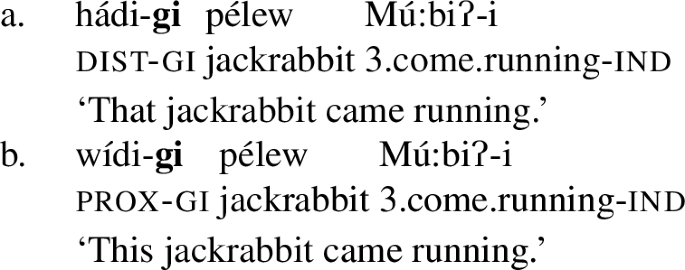
As mentioned briefly in Sect. 1, the morpheme gi is not limited to this environment.Footnote 12 Crucially, it is also a realization of the independent third person pronoun in the language, as shown in (26), where nominative gí: is the subject, and in (27), in which accusative gé: is the object:Footnote 13
-
(26)

-
(27)

On the basis of this decomposition, Hanink (2018) argues that the morpheme gi/ge is the realization of idx both in pronouns and demonstratives.Footnote 14 She treats demonstratives as a special type of D (King 2001; Roberts 2002; Wolter 2006; Elbourne 2008), which, like the definite article, co-occur with indices in order to give rise to a deictic interpretation (cf. Kaplan 1989). Recall that, on this decompositional view, the meaning of D is constant—it merely encodes uniqueness (and here, a spatial relation)—while the function of the index is to introduce a variable that may refer either back to an antecedent, on its anaphoric use, or refer deictically, on its demonstrative use. The structure of the demonstrative in Washo can then be understood as a familiar anaphoric DP with precisely the same structure proposed for German as in (13), in which the deictic element hádi (28) or wídi (29) occupies D, and in which idx is overtly realized by -gi. As in German, D lowers to idx when it is present, resulting in the complex forms hádigi/wídigi.
-
(28)
Proximal demonstrative
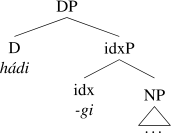
-
(29)
Distal demonstrative
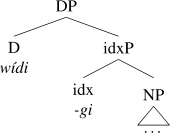
The core of the above proposal is that gi/ge has the general function in the language of an index-encoding expression, and represents the overt exponence of idx. This explains its use in pronouns as well as its presence in demonstratives, where its interpretive role is the same. There is however evidence that demonstratives are more complex than ‘simple’ anaphoric DPs, which complicates the above proposal and necessitates some revision. In (31) for example, the proposed structure of the demonstrative is precisely the same as the structure of an anaphoric bare definite (30)—differing only in overt exponence of D and idx, which are both phonologically unrealized in the latter—leading to the following structures in Washo (to be revised):
-
(30)
Anaphoric DP

-
(31)
Demonstrative DP
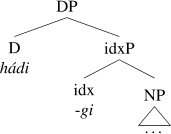
However, this identity in structure is probably too simple. For instance, building on Nunberg (1993), Elbourne (2008) proposes that, in additional to an index argument, demonstratives have two additional components differentiating them from mere anaphoric definites (cf. King 2001). First, demonstratives must encode either a distal or proximal component (governing ‘that’ vs. ‘this’ respectively). Second, demonstratives contain a relational component, whose purpose is to “constrain the relation that must hold between the index and the interpretation” (Elbourne 2008:419). In the general case, R gives rise to a functional identity relation, as schematized in (32) in the implementation of Elbourne’s system proposed in Simonenko (2014):
-
(32)

The purpose of R is essentially as a mediator, and it can take on other meanings beyond identity. For instance, when used to convey a co-varying meaning such as the one in (33), Elbourne argues that the R variable can encode a relation of exemplification, in that it doesn’t directly refer.
-
(33)
Every father dreads that moment when his eldest child leaves home.
On the first point, we can capture the proximal/distal distinction in Washo with the following lexical entries, which, following Elbourne, place this difference in D itself, as evidenced by the difference in morphological forms.Footnote 15
-
(34)

On the second point, I follow Nunberg’s and Elbourne’s proposal for the necessity of the relational component in demonstratives, which Elbourne encodes directly into the structure of the DP. In subsequent work, Simonenko (2014) proposes a structure for Bavarian demonstratives that places the relational component in a functional projection RP below the index layer, which I adopt here. Below, (35) exemplifies the derivation for (23) on this view.Footnote 16
-
(35)
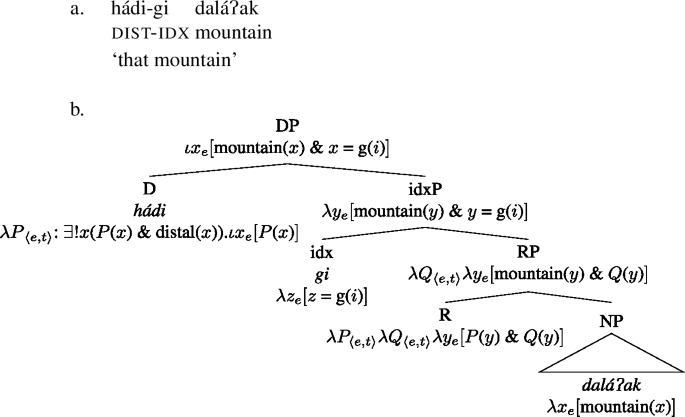
With this structure in mind, the main take away is the proposal that gi/ge is the overt realization of idx in Washo. It is not itself D, which is realized independently as either wídi or hádi; in the case of anaphoric bare definites, idx is present to encode an anaphoric meaning as in Schwarz (2009), but goes unpronounced along with a silent D (Sect. 3.2 offers arguments for a null D in Washo, despite the absence of an overt definite article in bare definites). To summarize, the differences in the respective structures are schematized below:
-
(36)
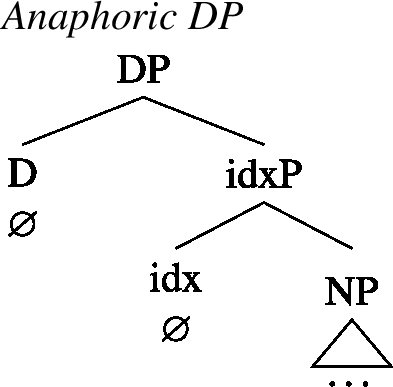
-
(37)
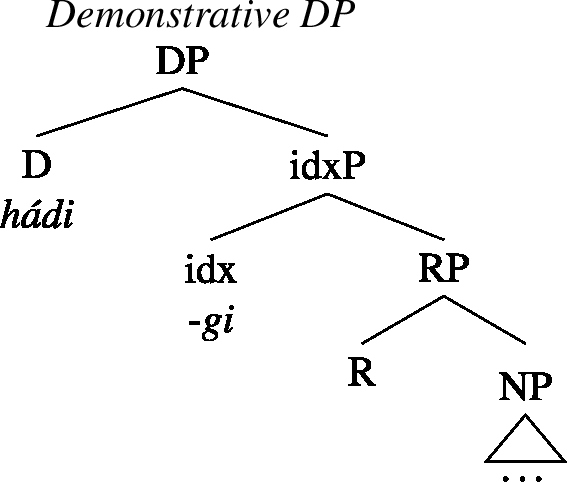
In Sec. 6 I return to the obvious issue of why idx should not be pronounced in anaphoric bare definites, if it is in fact required in the structure to introduce an anaphoric meaning. To offer a preview of the analysis (38), I will argue that idx is not pronounced whenever it takes an overt nominal complement (38c). In anaphoric bare definites, this condition is met, and idx goes unpronounced. In demonstratives on the other hand, idx takes RP as its complement, rather than NP. It will be shown that this allomorphy likewise governs the appearance of gi/ge in pronouns as well as at the periphery of internally headed relatives.
-
(38)
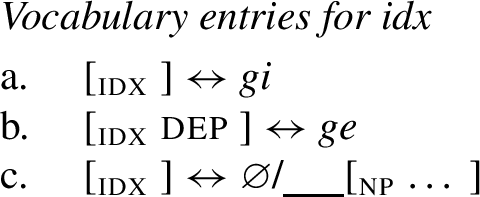
I have summarized in this section morphological evidence that indices are overtly realized in the structure of familiar definites in Washo, and have proposed a more refined structure for demonstratives from that in Hanink (2018) that is still able to capture this generalization. In the next section, I turn to a construction in the language where the presence of idx is seemingly puzzling in light of this discussion: internally headed relatives, a type of complex DP with gi/ge at its periphery.
3 Internally headed relatives
Relative clauses in Washo are exclusively internally-headed (Jacobsen 1964, 1998).Footnote 17 Such relative clauses are termed as such (e.g., Langdon 1977) when the semantic head remains inside the embedded clause. In (39) for example, the semantic head šáwlamhu ‘girl’ remains in its typical SOV position within the subordinate clause, rather than in a position outside it (as in externally headed relatives).Footnote 18 The embedded clause is nominalized, and this nominal acts as the subject of the matrix verb (Peachey 2006; Hanink 2016). Note crucially that the suffix -gi at the right periphery of the relative clause in (38) is precisely the same form as the proposed realization of idx.
-
(39)

Based on their morphosyntactic behavior, I adopt the proposal that internally headed relatives constitute full CPs that are nominalized to become DPs (see also Peachey 2006). In what follows, I argue that the presence of the morpheme gi/ge in internally headed relatives is indicative of precisely the same idxP layer that is found in pronouns and demonstratives. This leads to the structure in (40), in which idx selects for a CP as its complement, rather than for an NP as it does in familiar definites.Footnote 19
-
(40)

While internally headed relatives are not familiar like anaphoric DPs or demonstratives, I motivate this structure in Sect. 4 by arguing that the role of the index in (40) is to bind a variable in the embedded clause, rather than to act as a variable, explaining why gi/ge surfaces in this construction. By postulating two possible (related) meanings for idx, the present proposal is able to unify the appearance of this morpheme within a variety of DP types. Before proposing this analysis, I turn first to the crucial morphosyntactic properties of relative clauses in Washo.
3.1 The structure of internally headed relatives
In this section, I elaborate on the structure for IHRCs proposed in (40). To do so, I first motivate the assumption that the embedded clause constitutes a full CP embedded within a DP. I then discuss relevant properties of the suffix -gi/-ge on its use in internally headed relatives. Finally, I provide arguments for the status of Washo as a DP language (in the sense of Bošković 2008), despite the fact that it lacks an overt definite article outside demonstratives.
3.1.1 Internally headed relatives contain full CPs
Evidence that a full CP is embedded within the nominalization in IHRCs comes first from the fact that these clauses host complete tense, aspectual, and mood information (Peachey 2006). In (41) for example, the intermediate past tense suffix -aʔy occurs, as well as the ‘default’ independent mood suffix -i. While Washo is an optional tense language (Bochnak 2016), mood is the anchor of the clause and is always present.Footnote 20 I return to the -gi/-ge distinction—the reflex of case—in Sect. 3.1.2.
-
(41)

Additional evidence for a full clausal structure comes from the observation that internally headed relatives obligatorily mark switch reference—a cover term referring to grammatical markers that track whether the subjects of two clauses are coreferent (Jacobsen 1964, 1967, 1998; see McKenzie 2015 for a recent overview of switch reference in North America). The presence of the morpheme -š indicates that the subject of an embedded clause is distinct from the subject of the clause that embeds it (the same subject marker is null). In (42) for example, the subject of the embedded clause is the addressee, while the subject of the matrix clause is the speaker. As a result, the different subject marker -š obligatorily appears on the embedded verb:
-
(42)

Building on Finer (1985) and Watanabe (2002), Arregi and Hanink (2018) argue that switch reference morphology is a realization of embedded C (agreeing with both the matrix and embedded subjects), which is the highest head in the structure of the embedded clause.Footnote 21 While there are no other overt complementizers in Washo, switch reference morphology signals the presence of C in the structure.
Adopting this assumption, the structure I propose for a nominalization such as (41)is then as in (43). I follow Giannakidou’s (2009) proposal for Greek by treating the independent mood suffix -i as a realization of the head Mood. I further treat D and idx as head initial, to mirror their appearance in demonstratives (28), and to reflect the fact that modifiers in Washo (e.g., quantifiers, numerals) are neutrally head initial.
-
(43)
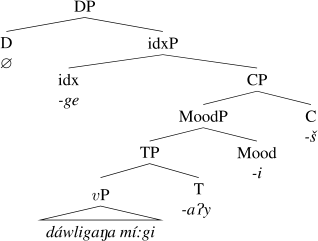
Finally, in order to explain the suffixation of -gi/-ge onto the embedded clause, I propose that idx lowers onto the C head that it immediately c-commands and precedes, explaining the suffixal nature of this morpheme.Footnote 22 Having motivated the CP status of the embedded clause in internally headed relatives, I now turn to the proposed DP layer in this construction.
3.1.2 Internally headed relatives are DPs
I now motivate the treatment of IHRCs as DPs by providing evidence from two crucial behaviors of this construction that go hand in hand: IHRCs are i) matrix arguments, and ii) assigned case by the matrix verb. Case on IHRCs is realized solely on the suffix -gi/-ge, and reflects the grammatical role of the IHRC in the matrix clause, i.e., it undergoes the same case alternation that the independent third person pronoun does, between a nominative and accusative form (see Sect. 2):Footnote 23
In internally-headed relatives, this case distinction is reflected by the role that the relativized argument plays in the matrix clause. In (44), for example, the entire nominalized clause (‘the girl that the man saw’) is the subject of the matrix verb -eʔ- ‘be’. The resulting suffix is therefore nominative -gi.
-
(44)

In (45) on the other hand, the nominalized clause is the object of matrix ‘see,’ and the accusative form of the suffix, -ge, appears:
-
(45)

Aside from case and argumenthood, an additional piece of evidence for the DP-hood of internally headed relatives comes from the fact that they can act as arguments of postpositions (see also Peachey 2006). Consider the instrumental postposition -lu, which in (46) selects for the DP ditulíc’ik ‘my finger’:
-
(46)

The same postposition can instead select for an internally headed relative clause, in this case resulting in a causal interpretation also available in English:
-
(47)

Taken together, the above data show that internally headed relatives in Washo are DPs containing full clauses. Unlike in demonstratives, however, no D head is morphologically realized in internally headed relatives. Before moving on to the semantic role of idx in IHRCs, I therefore motivate in the next subsection the presence of a null D head, which allows for a parallel structure between IHRCs and familiar definites.
3.2 Washo as a DP language
Adopting the syntax for IHRCs as in (48) (repeated from (40)) results in a unified view of both familiar DPs and the more complex internally headed relatives. On this view, idx is a separate head from D: gi/ge is the realization of idx; D on the other hand is not overtly realized. The treatment of D and idx as separate heads reflects their independent semantic contributions in familiar definites: D contributes uniqueness, while idx contributes familiarity. This raises the question however of whether there is evidence for a null D head in Washo (in nominalizations or otherwise), given the fact that there is no overt definite article outside demonstratives (cf. (19)-(22)).
-
(48)
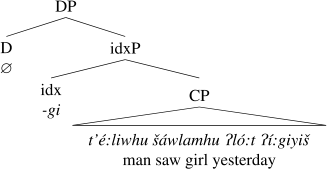
I therefore turn now to present arguments supporting the view that Washo does in fact make use of a silent definite article, drawing on correlational tests for the presence of D identified by Bošković (2008). In his work on NP vs. DP languages, Bošković identifies several correlations observed in languages that make use of articles versus those that don’t (see also Bošković 2009; Bošković and Hsieh 2015; Norris 2018). He argues that languages without an overt article may truly lack a DP-layer altogether; I argue that this is not the case for Washo. Two of Bošković’s correlations are directly concerned with internally headed relatives, and have to do with locality constraints and restrictiveness, which I address here. The languages informing Bošković’s generalizations on internally headed relatives are Japanese, Quechua, Navajo, and Mohawk, a typology we can compare Washo against.
The first correlation identified in Bošković (2008) concerns the island sensitivity of internally headed relatives. On this point, he arrives at the generalization in (49).
-
(49)
Locality: Internally headed relatives are island sensitive in languages without, but not with, articles.
The cross-linguistic generalization proposed in (49) is that IHRCs in languages with articles are not sensitive to island boundaries. Crucially, examination of Washo reveals that relative clauses in the language are not island sensitive. Consider the examples in (50) and (51).
-
(50)

-
(51)

In both of these examples, one relative clause is embedded inside another. In (50), the semantic head in the deeper relative clause (in bold) is t’ánu ‘people’, while the semantic head of the higher relative clause (in italics) is démlu ‘food’, which is the subject of the matrix clause. In (51), the lower head is daʔmóʔmoʔ ‘woman’ while the higher head is gó:beʔ ‘coffee’. The higher semantic head in both cases is located inside a relative clause island; nevertheless, the structures are grammatical. Washo therefore patterns with DP languages when it comes to island (in)sensitivity; I return to the issue of why this should correlate with the presence of D in Sect. 4.5.
Bošković’s second correlation regarding IHRCs has to do with restrictiveness, with the resulting generalization in (52):
-
(52)
Restrictiveness: Internally headed relatives are restrictive in languages with articles.
On this point, Grosu and Landman (1998) offer two diagnostics to test for restrictiveness in internally headed relatives. The first is the availability of both definite and existential interpretations. While we have already seen relative clauses with a definite interpretation (e.g., (45), (47)), IHRCs may also receive an existential interpretation in Washo. In (53), for example, the IHRC is interpreted as an indefinite, as the heron is being introduced for the first time (I return to this interpretation in Sect. 4.3.1):
-
(53)

The second diagnostic for restrictiveness identified by Grosu and Landman (1998) is the ability for IHRCs to stack. Washo relative clauses do stack, as shown in the example in (54), in which two relative clauses intersectively modify a single semantic head, súkuʔ ‘dog’. Washo therefore also patterns with determiner languages with respect to restrictiveness.
-
(54)

The upshot of these data is that internally headed relatives are both island insensitive and restrictive. According to Bošković’s generalizations, these diagnostics place Washo in the class of DP languages, even though the definite article is not pronounced; this is consistent moreover with the treatment of demonstratives as a special type of D.Footnote 24 Moving forward, I maintain the proposal that the Washo DP contains a silent definite article in cases where it is not pronounced, in accordance with the DP hypothesis (Abney 1987; see also Longobardi 1994 and Progovac 1998, as well as Jenks 2018 and Norris 2018 for similar conclusions for Mandarin and Cantonese, and Estonian, respectively). Having motivated both a CP and DP layer in IHRCs, I turn in the next section to the semantic role of idx at the periphery of Washo relative clauses.
4 The role of the index in IHRCs
With the crucial morphosyntactic properties of internally headed relatives established, I now turn to the semantic role of idx. Crucially here, I argue that the meaning of idx in IHRCs differs from its interpretive role in familiar definites. While idx introduces a variable meaning in the latter, I argue that the index in IHRCs instead binds a variable in the embedded clause, which on its own denotes an open proposition. As both the variable and variable binder meanings of idx are related, the proposal unifies the treatment of gi/ge in both familiar definites and IHRCs.
4.1 The anaphoricity puzzle
In Sect. 2, I argued that idx is realized by the morpheme gi/ge in familiar definites in Washo. The realization of indices in this way reveals an isomorphism in the grammar, in the sense that the semantic index is housed on a dedicated idx head, which is overtly realized by its own morpheme (see also Schlenker 2017 on ASL). I then argued in Sect. 3 that the suffix -gi/-ge in internally headed relatives is another realization of idx, based on the shared morphological realization of this morpheme in third person pronouns, demonstratives, and at the periphery of IHRC nominalizations. Importantly however, internally headed relatives differ from pronouns and demonstratives in a crucial way: They need not be anaphoric or deictic, which at first glance makes the presence of the suffix -gi/-ge mysterious if its semantic role remains constant across this constellation of constructions.
The puzzling appearance of the index in relative clause in Washo hearkens back to a puzzle from English first pointed out by Hawkins (1978): Relative clauses license the definite article even in cases when the referent it picks out is neither (strongly) familiar nor anaphoric. Hawkins cites examples such as the following (which he terms ‘establishing’ relatives), in which (55b) is a felicitous response to the question posed in (55a). The response in (55c), by contrast, is not.
-
(55)
-
a.
A: What’s wrong with Maria?
-
b.
B: The car
 that she bought last month ] already broke down.
that she bought last month ] already broke down. -
c.
B′: # The car already broke down.
-
a.
Hawkins notes that the presence of the relative clause in (55b) appears to license the use of the definite article, which on its own is infelicitous. Relatedly, IHRCs in Washo likewise need not be anaphoric (or deictic for that matter, as in the case of demonstratives), even though idx is apparently present in the form of the suffix -gi/-ge. For example, (56) may be uttered in an out of the blue context.
-
(56)

Given that idx in relative clauses—if in fact present—is not contributing familiarity, but is nevertheless licensed by the presence of a relative clause, then the question arises as to why it is there at all. I argue below that idx is present in the IHRC not to refer, but to bind a variable in the embedded clause in the absence of Ā-movement, allowing the relative clause to denote a property of individuals—the correct interpretation—before composing with the definite article.
4.2 Movement in internally headed relatives
The puzzle posed by internally headed relatives from the perspective of the syntax-semantics interface is that relative clauses of this type are essentially propositions with the addition of nominalizing morphology at their periphery (Langdon and Munro 1979; Culy 1990). In spite of this, the entire resulting DP refers to the ‘semantic head’ within the embedded sentence, denoting crucially an individual, rather than a proposition. For example, the IHRC in (57) refers to a particular coyote:
-
(57)

The situation is different in the case of externally headed relative clauses. For example, under a raising account of relative clauses (i.a. Brame 1968; Schachter 1973; Vergnaud 1974; Kayne 1994; Bianchi 1995; Bhatt 2002), the ‘semantic’ head starts out inside the relative clause, but is ultimately interpreted and pronounced outside of it, in the matrix clause:
-
(58)
-
a.
‘the coyote that the boy saw’ (English)
-
b.
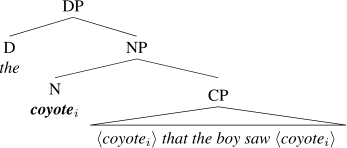
-
a.
On the raising analysis as in (58), a relative operator triggers movement of the semantic head to Spec, CP, from where it undergoes a second step of movement to land in its final matrix position. From an interpretive perspective, Ā-movement of the nominal results in λ-abstraction and a property-denoting relative clause that is able to intersectively modify the moved noun phrase, resulting in the meaning in (59):
-
(59)

This entire NP can then compose with the definite article to achieve the correct meaning for the DP – the unique individual coyote seen by the boy (60).
-
(60)

In IHRCs on the other hand, this is not so: the ‘semantic head’ remains inside the embedded clause as in (61), and never appears in a matrix position. How a restrictive meaning arises from an internally headed relative (in the absence of movement) is therefore mysterious at first glance.
-
(61)
-
a.
‘the coyote that the boy saw’ (Washo)
-
b.
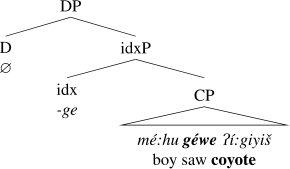
-
a.
In order to explain the discrepancy between surface structure and interpretation, many analyses have assimilated internally-headed relatives to externally-headed relatives to some degree at LF, arguing either for covert movement of the semantic head all the way to a matrix position (Lefebvre and Muysken 1988; Cole 1987; Cole and Hermon 1994; Broadwell 1985, 1987), or to an Ā-position but no further (Williamson 1987; Barss et al. 1990; Culy 1990; Bonneau 1992).
Motivation for a covert movement analysis is the fact that the languages under discussion (largely) display evidence for covert movement on a par with the overt movement observed in languages like English. Such evidence comes from, e.g., locality effects as diagnosed by island sensitivity in extraction. For instance, in his seminal paper on Quechua, Cole (1987) assimilates internally headed relatives to externally headed ones at LF on the basis of island effects, which show that internally headed relatives (62) ban extraction in the same way as externally headed ones (63) (the language makes use of both strategies; Cole 1987:286-287):
-
(62)

-
(63)

On Cole’s account, internally headed relatives can be analyzed under a standard raising account at LF, and merely display different PF properties from English-like languages: The semantic head of the relative clause is pronounced in-situ, rather than in its derived position (Cole 1987:278):
-
(64)
S-Structure
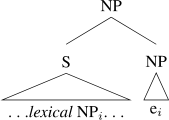
-
(65)
LF-structure
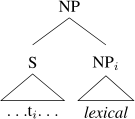
As shown by Basilico (1996) however, not all internally headed relatives display island effects, and therefore do not necessarily motivate a movement-based analysis of IHRCs. Basilico demonstrates this with grammatical examples such as the following from Mojave (apud Munro 1976:204) in (66):
-
(66)

Unlike Quechua, (66) demonstrates that internally headed relatives in Mojave are not island sensitive and therefore do not offer evidence for movement. This distinction in island sensitivity has been proposed by Grosu (2002, 2012) to create a cut across two types of languages with internally headed relatives: i) the definite/restrictive type, including Mojave and those languages in which IHRCs are island insensitive, and ii) the maximalizing type, including Quechua and Japanese, in which IHRCs are island sensitive (see e.g., Dayal 1991a,b on Quechua; Hoshi 1995 and Shimoyama 1999 on Japanese). As discussed by Grosu (2002, 2012), additional diagnostics for being a language of the definite/restrictive type come from i) the availability of indefinite interpretations of the relative clause; and ii) the ability for relative clauses to stack (which were already mentioned above in (53) and (54), respectively, during the discussion of correlations with the presence of D). Internally headed relatives in maximal-type languages such as Japanese and Quechua do not allow for either of these (see e.g., Shimoyama 1999 for an e-type analysis of Japanese).
Crucially, Washo patterns with the definite/restrictive language type. As was discussed in the previous section on evidence for a DP layer in Washo, internally headed relatives in the language do not display island sensitivity. The relevant type of example is repeated below in (67) from (50):
-
(67)

Such examples are impossible under a movement analysis: Ā-movement of the deepest semantic head t’ánu ‘people’ in (67) would block subsequent movement of the intermediate head food, as it would be located in a relative clause island. Note that it is not the entire lower nominalization that can act as the semantic head in this case, as this nominalized clause refers to the wrong individual (‘people,’ not ‘food’), which is what makes such examples crucial for arguments against a movement analysis.
-
(68)

The island insensitivity of internally headed relatives in Washo means that there is no evidence for covert movement of the semantic head. As a result, IHRCs in Washo cannot be assimilated to externally headed relatives at LF in the spirit of, e.g., Cole’s (1987) analysis of Quechua. In what follows, I build on Basilico (1996) and propose instead that idx at the periphery of the clause achieves the same result as Ā-movement in externally headed relatives by binding an open variable in the embedded clause.
4.3 The semantic head
Given the lack of movement in internally headed relatives in Washo, the question that arises is how the entire relative clause comes to ‘refer’ to the semantic head contained within the IHRC—in other words—how the semantic head becomes bound in-situ. To address this question, I build on insights from Jelinek (1987), Basilico (1996), and Watanabe (2002), who have argued that the interpretation of IHRCs need not involve movement, but may instead be derived by long-distance binding (see also Srivastav 1990; Culy 1990). More specifically, these authors argue that IHRCs begin life as open propositions in which the semantic head denotes a restricted variable, and that this variable is ultimately bound by something higher in the clause to return a property-type meaning, usually a determiner-like element at the periphery. In the case of Washo, I claim that idx is precisely the syntactic element at the periphery of the clause responsible for binding the semantic head.
Following Jelinek (1987) and others, I assume that the semantic head of IHRCs is a restricted variable along the lines of a Heimian indefinite (Kamp 1981; Heim 1982). On this view, the indefinite provides a variable along with a restriction on that variable, as in (69) (for further discussion on this approach to indefinites in IHRCs, see Basilico 1996:507).Footnote 25 Heimian indefinites contribute a predicate alongside a variable that must be bound during the course of the derivation of the relative clause, in this case by a higher operator. The meaning in (69) exemplifies the treatment I adopt for semantic heads such as coyote, which is along the lines of an indefinite pronoun (cf. Condoravdi’s 1989 treatment of \(\mathit{pro}_{\mathit{arb}}\) as an indefinite pronoun).Footnote 26
-
(69)

This proposed property of semantic heads (i.e., that they must be bound) is generally assumed to be responsible for achieving the meaning of the relative clause in the absence of (covert) movement in languages like Mojave. This approach results in the following meaning of the embedded clause, which, on its own, denotes an open proposition with a bindable free variable (the semantic head):
-
(70)

The resulting questions are then i) what binds this open variable to make the proposition well-formed; and ii) how the correct individual reading of the internally headed relative is derived from this underlying propositional meaning. I propose that the role of the idx head -gi/-ge at the periphery of the clause is to bind the open variable denoted by the semantic head, returning a property that mirrors the resulting composition of the relative clause and external head noun as in (59) above:
-
(71)

The silent definite article in the structure then takes this property to return an individual, performing the same function that the definite article does in English (i.e., ι) to arrive at a meaning such as (72), on a par with that in (60):
-
(72)

Put in a different way, the index at the periphery of the clause does what λ-abstraction would otherwise do: It forms a property from an open proposition, which can then be converted to an individual through composition with the definite article. This binding relation is schematized in the configuration in (73):
-
(73)

In the next section, I spell out more concretely how this proposal works, and show that it reveals the dual nature of idx that is reflected by the morphology of Washo.
4.3.1 Indices as binders
The idea that an index may itself act as a variable binder is not a novel one. Notably, Heim and Kratzer (1998) demonstrate that indices may not only be interpreted as indices, but also as binders in their own right. When interpreted as a binder, an index denotes a λ-operator that is coindexed with the lower variable it binds. Further, the locus of binders in recent work has been argued to be housed in c-commanding functional heads, rather than on an antecedent per se (Adger and Ramchand 2005; Kratzer 2009; McKenzie 2012). To give an example, consider the following example.
-
(74)
Ii blame myselfi.
Kratzer (2009) argues that the reflexive in (74) is bound not by the antecedent subject pronoun, but by the functional head v: As shown in (75), the two are co-indexed, and enter a binding relation through the introduction of a λ-abstractor by \(v^{0}\) (76):
-
(75)
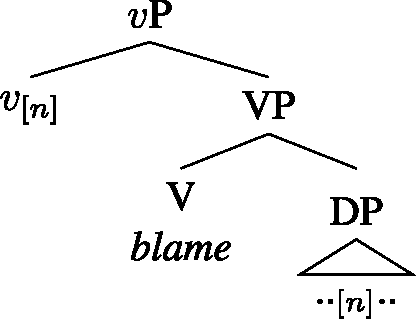
-
(76)
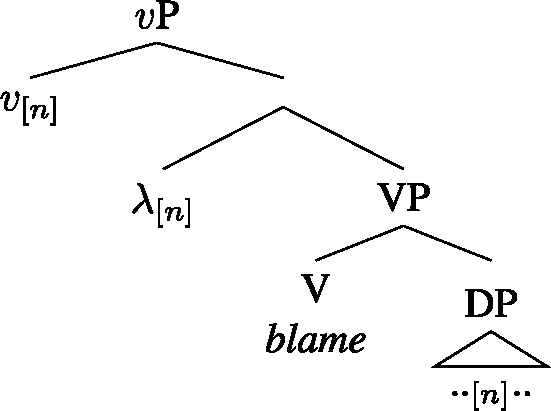
Importantly, functional heads that can perform as binders are not limited to v (e.g., C is also a binder for Kratzer). What I propose therefore is that the suffix -gi/-ge in internally headed relatives is the overt realization of the functional, index-hosting head that binds an open variable in the proposition denoted by the embedded clause (77). Important, the morphology of Washo reveals that idx is realized by the same morpheme—gi/ge—in both demonstratives and pronouns, on its variable interpretation, and at the edge of IHRCs, on its variable binder interpretation.
-
(77)
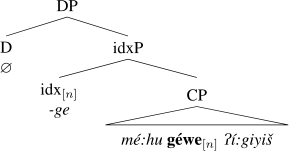
I now turn to what precisely the meaning of idx is on its use as a variable binder. For Kratzer (2009), binding by a functional head is triggered by the insertion of a λ-abstractor, as in (76). There is however a perhaps (here) more satisfying alternative for the meaning of idx, which relates to work by Heim (1998) on the proposed distinction between so-called inner vs. outer indices (stemming from predecessors in Montague 1974 and Higgenbotham 1983). According to Heim (1998), there are two types of indices required for the interpretation of pronouns. The first type are inner indices, which have a variable-type meaning; the second type are outer indices, which are themselves variable binders. To paraphrase from Kennedy (2004), the difference between the two types of meanings is between “those that specify the name of a variable-denoting expression, and those that indicate which variables an expression binds” (Kennedy 2004:31). For example, in a sentence such as (78), the pronoun ‘he’ is not only bound by the universal quantifier, but is also a binder of the possessor ‘his’ (Heim 1998:229).
-
(78)
Every boy \(\lambda _{1}\) [t1 said that he1 \(\lambda _{2}\) [t2 called his2 mother]].
Based on such examples, Kennedy argues that the index feature hosted on a given index is complex and best represented by an attribute value matrix that has two types of values, bind and var, as schematized in (79):Footnote 27
-
(79)
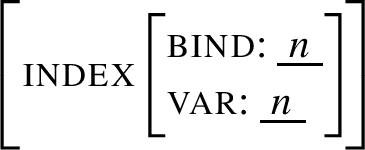
Building on this work, I propose that the availability of both types of meanings for an index leads to a polysemy in the types of meaning an index can have (see also Grove and Hanink 2016; Hanink and Grove 2017), and that the status of -gi/-ge as idx results in the ability of this head either to introduce a variable meaning (as in familiar definites) or to bind (as in IHRCs). In (80), (a) then represents the meaning of idx on its variable interpretation, while (b) represents its meaning on its use as a binder; this latter meaning essentially achieves the ‘index adjunction’ of Predicate Abstraction without movement.Footnote 28
-
(80)

With all the ingredients of the analysis in place, a complete derivation for an IHRC is given in (81). First, the embedded CP denotes a proposition containing a restricted variable.Footnote 29 Second, idx with the meaning in (80b) takes this proposition as its complement and binds the free variable, returning a property of individuals: the correct meaning of a restrictive relative clause. Finally, this property composes with the (unpronounced) definite article, which returns the individual coyote that the boy saw. Note that by adopting this approach, we arrive at the same meaning of an externally-headed relative, but with different steps in the derivation.
-
(81)
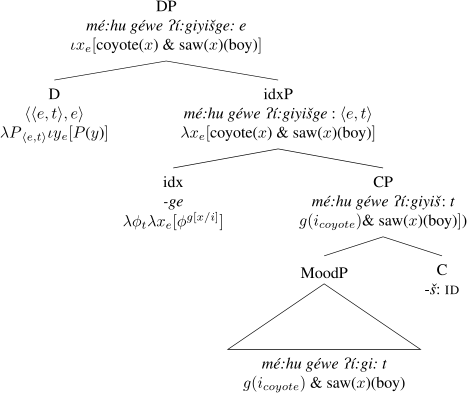
The main result here is that, once indices are treated as syntactic objects, it follows that the head realizing idx should be able to encode both meanings that indices have been argued to perform in the interpretive component of the grammar.Footnote 30 Washo provides evidence for this directly: The same morpheme gi/ge, argued to realize idx, may perform both the role of a variable and of a variable binder.Footnote 31
Before moving on, I point out that I have so far given an analysis of internally headed relatives in Washo only with a definite interpretation. However, internally headed relatives may also receive an existential interpretation, as in (53). There are at least two options to derive this meaning. The first is to assume that the silent D head is ambiguous between a definite and an indefinite article. If D is an indefinite article, it will select for idxP as its first argument before composing with the matrix clause. The second option is that internally headed relatives on an existential interpretation simply lack D altogether, i.e., their highest projection is idxP. In this case, we can assume an Existential Closure Shift (Partee 1986; Dayal 2004), in the spirit of Caponigro’s (2004) proposal for the interpretation of certain free relatives.
4.4 Back to German
Importantly, Washo is not alone in making use of idx for binding in relative clauses. A parallel phenomenon has in fact been discussed for German, in which the morphology of the external heads of relative clauses points to the unexpected presence of an index (Grove and Hanink 2016; Hanink and Grove 2017; see also Simonenko 2014, 2015 for a related problem in Bavarian). Recall the contraction facts introduced in Sect. 2. The definite article on its unique use may contract with a preceding preposition, as in (82), while anaphoric definites on the other hand do not contract (83):
-
(82)

-
(83)
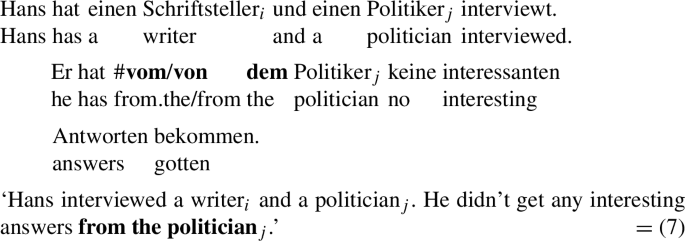
This generalization is robust in German. As Schwarz points out however, outside of anaphora, the external determiner of the head of an externally headed relative clause may likewise not contract, even though it is not anaphoric (84):
-
(84)

Schwarz leaves such uses of the strong, anaphoric form of the article aside. However, while I do not go into the details of the analysis here, Grove and Hanink (2016) and Hanink and Grove (2017) propose that the morphological form of the external determiner is strong because it does in fact contain an index, taking the morphology at face value. As in Washo IHRCs, the index is required for binding purposes; while in Washo this is due to the structural nature of IHRCs and a lack of movement, in German it is due largely to a quirk of morphology. In a nutshell, the relative pronoun is just a determiner (Wiltschko 1998), and cannot perform the normal role of a wh-pronoun. Therefore, while German does make use of Ā movement in the derivation of the relative clause, the lack of a true relative pronoun precludes λ-abstraction over the relativized argument. For this reason, relative clauses denote open propositions and the matrix index is needed to bind the open variable left behind.
From such data, we see that the presence of an index external to restrictive relatives is motivated not only by Washo, but also by cross-linguistic data from German. Again in both cases, Washo displays overtly what is only indirectly observable in German through contraction: idx is present at the periphery of the relative clause in order to bind an open variable. On an analysis where idx is not a part of DP structure (e.g., indices are hosted on D), we lose the ability to capture this generalization.
4.5 Binding and island insensitivity
At this point, more needs to be said about the nature of the co-indexing relation between idx and the semantic head. In the above proposal, the semantic head of the relative clause comes to be bound by the higher, c-commanding functional head idx. I repeat here the schematic from (73), showing this:
-
(85)

One question that arises from this proposal is how idx comes to be co-indexed with the semantic head it binds. For example, in Heim (1982), an operator binds an indefinite when the index associated with the indefinite NP is copied onto the operator (which, in this case, would be idx). This operator must be the lowest c-commanding operator, a condition on minimality. In Kratzer’s (2009) proposal on the other hand, the matching of indices between binder and bindee is not governed: It is simply a precursor for syntactic binding, which may either occur or not occur. In order to rule out derivations in which the indices do not match, we can then invoke Heim and Kratzer’s prohibition against derivations in which an operator does not bind anything, as described in (86) (Heim and Kratzer 1998:126):
-
(86)
Prohibition against vacuous binding Each variable binder must bind at least one variable.
I adopt the latter approach, and propose that the relationship between idx and the semantic head is not one of index inheritance. One core piece of evidence that inheritance is not involved comes from island insensitivity. Taking Heim’s suggestion at face value, we would need a notion of Agree along the lines of e.g., (87)(from Merchant 2014b; cf. Chomsky 2000, 2001):
-
(87)

On an Agree-based analysis, idx with an unvalued index feature would undergo some type of agreement with the lower semantic head, as schematized in (88):
-
(88)
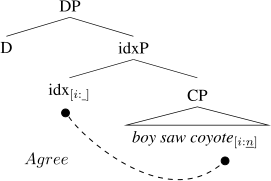
Beyond the issue of the clearly non-local agreement between idx and the internal head (given the lack of evidence for movement inside the IHRC), this approach faces problems from multiple embedding. Consider again the example repeated from (50), demonstrating the island insensitivity of IHRCs:
-
(89)

Such examples cannot be accounted for by an Agree-based analysis: It is impossible for the higher idx head to find an index feature to agree with in the most deeply embedded clause, as it would have to probe past a CP boundary, violating minimality:
-
(90)

While this problem has not been addressed (to my knowledge) in other accounts of island insensitive IHRCs, enforcing the ban on vacuous binding in (86) allows us to explain the apparent lack of movement inside this class of relative clause whilst still getting the meaning right.
Additional evidence that agreement does not take place comes from the lack of inflection on the nominalizer. For Kratzer, φ-features on a bound DP are inherited from the functional head that binds the DP (‘Feature Transmission under Binding’; Kratzer 2009:195). No such feature transmission is observed in Washo. This can be seen in the third person pronominal paradigm in Washo, given in Table 1.
If ‘feature transmission’ (or agreement) were taking place, we might expect to see the φ-features of the semantic head realized on idx. This is not born out; even in cases where the semantic head is e.g., plural, the form of idx is invariantly -gi/-ge and does not reflect number distinctions, which would be taken as the result of agreement between e.g., idx and daʔmoʔmóʔmoʔ ‘women’ in (91).
-
(91)

Taken together, the evidence from locality considerations, islands, and the morphology of -gi/-ge suggests that there is no agreement between idx and the semantic head, indicating that no feature transmission takes place in IHRCs.
At this point I return to Bosković’s (2008) correlation concerning the NP/DP distinction and island sensitivity. His locality correlation is repeated in (92):
-
(92)
Locality: Internally headed relatives are island sensitive in languages without, but not with, articles.
What Washo and Mojave tell us is that movement is not necessary to derive an internally headed relative in some languages. In the absence of movement, long-distance binding by idx becomes available instead (cf. Basilico 1996). Cross-linguistically then, we should find that languages with clause-peripheral DP structure allow for derivations without movement. Beyond Washo, this prediction is born out for example by Lakhota, which has a fully articulated article system (94).Footnote 32 Lakhota, like Washo, has determiners and therefore does not need movement to derive the correct meaning for the relative clause.
-
(93)

In languages that show island sensitivity on the other hand, the nominalizing morphology at the edge of the clause is not necessary for long distance binding—just as a nominalizer is not necessary for English—because movement is available.Footnote 33 In an island-sensitive language such as Navajo for example (94), the need for movement can be understood to arise from the lack of material available to achieve long distance binding. Importantly, in (94), the relativizing suffix at the edge of the clause is not a pronoun or any other determiner-like object in the language; it simply marks the subordinate clause (Bogal-Allbritten and Moulton 2017).
-
(94)

Of course the question of what allows the availability of long distance binding of this kind to begin with is an open question (though see Watanabe 2002 for an attempt). The modest take away here is that the presence or absence of articles in a language—and how those articles are used, in nominalizations or otherwise—can partially determine whether or not movement is required in internally headed relatives.
5 Extensions of the analysis
In the next section, I present briefly two extensions of the current analysis. The first has to do with a point of typological variation in relative clauses, which concerns definiteness marking on the semantic head. The second has to do with clausal nominalizations that, unlike internally headed relatives, receive a familiar interpretation.
5.1 The indefiniteness restriction
Descriptively speaking, internally headed relatives in many North American languages obey a so-called ‘indefiniteness restriction’ (Williamson 1987), i.a. Mojave (Munro 1976); Lakota (Williamson 1987); Digueño (Basilico 1996); Hidatsa (Boyle 2016). This restriction requires the semantic head of IHRCs to be indefinite, in the sense that it cannot co-occur with strong determiners such as definite articles, demonstratives, or quantifiers. For example, in the Hidatsa (Siouan) relative clause in (95), the indefiniteness restriction is obeyed in that the semantic head wacée ‘man’ may not bear the definite suffix -š:
-
(95)

This generalization has been proposed to follow from the fact that the head of an IHRC must be indefinite so that it may be bound by a higher operator (e.g., Jelinek 1987; Basilico 1996), as discussed in greater detail in Sect. 4.3. Unlike indefinites, definite heads have been argued not to introduce a variable suitable for binding. Washo however does allow strong determiners in IHRCs, in that it allows a demonstrative as in (96).Footnote 34 Washo therefore does not obey the indefiniteness restriction found in many other languages with internally headed relatives.
-
(96)

I argue that it is precisely the presence of idx within Washo demonstratives that makes them suitable heads within IHRCs (in addition to Heimian indefinites as above, though anaphoric bare definites are predicted on this account to be suitable as well). The presence of idx in the structure introduces the necessary index for binding by the external instance of idx at the clausal periphery; it is the free variable in the meaning of (97) that is bound by the binder -gi/-ge at the periphery of the clause (cf. (35b)).
-
(97)

Beyond demonstratives, Washo also allows for quantified heads, as shown in (98). The italicized translation reflects the important fact that the quantifier does not take scope over the entire relative clause, which I return to below.
-
(98)
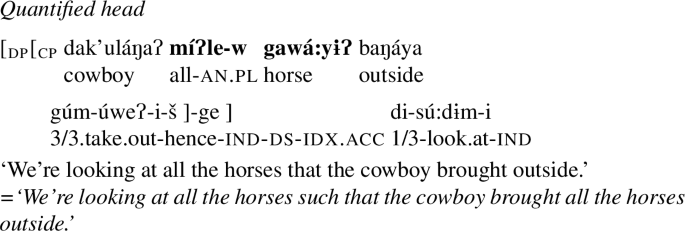
I propose that a similar explanation for the availability of quantifiers likewise follows from the structure of the Washo QP. The universal quantifier míʔleʔ in Washo is on a par with all rather than every, taking a plural restriction as shown in (99b):Footnote 35
-
(99)
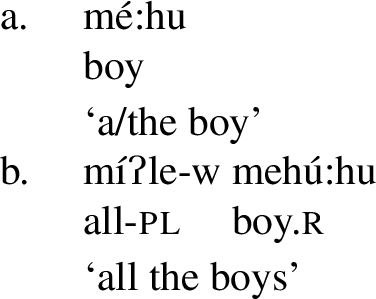
Quantified heads inside IHRCs as in (98) can then also be accounted for if míʔleʔ may select for an index-hosting DP with the structure as in (100), rather than for a property-denoting noun directly (Matthewson 2001:154). The associated meaning of all in Matthewson’s proposal is given in (100):Footnote 36
-
(100)

Applying this meaning to míʔleʔ in Washo, we arrive at the following meaning for a quantifier phrase as in (98):Footnote 37
-
(101)
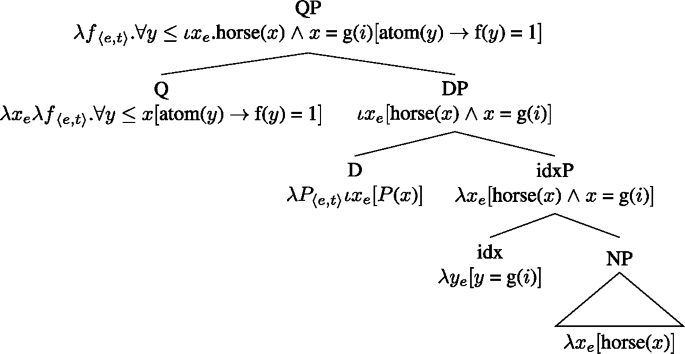
In (101), as in demonstratives, the presence of idx introduces the variable needed for binding by the higher idx head. Note that this meaning will obligatorily result in the quantifier taking scope only inside in the embedded clause, and will prevent it from taking matrix scope.Footnote 38 This is the correct result: If (98) is uttered, (102) is not a felicitous follow-up, indicating that the quantifier does not intersect with the meaning of the relative clause in (98) (it has only the nominal restriction ‘horse’).
-
(102)

In order for the quantifier to take matrix scope (i.e., to take the entire relative clause as its restriction), it needs to occur outside of the relative clause as a modifier in matrix position, where it may intersect with the entire embedded nominalization it selects:
-
(103)

Issues concerning the interpretation of quantifiers in internally headed relatives have been the focus of recent investigation, with languages displaying different behavior even with respect to different quantifiers in a single language (see e.g., Hastings 2004 on Quechua; Grosu 2012 and Bogal-Allbritten and Moulton 2017 on Navajo). While I merely scratch the surface of this topic here, the crucial take away is that the proposed account of internally headed relatives accounts as well for the puzzling violation of the indefiniteness restriction in Washo. The potential source of variation with respect to the indefiniteness restriction is then the type(s) of DP structures available in a given language. While in-depth work on the structure of DPs and the nature of internally headed relatives in languages exhibiting this restriction is warranted, the facts from Washo offer preliminary evidence for this claim.
5.2 Perception readings
Internally headed relatives are not the only type of clausal nominalization in Washo: The same surface structure can also give rise to what I will call ‘perception readings,’ following Kim (2009) and Moulton (2017) (the same are termed ‘event’ readings in Toosarvandani 2014). This construction is characterized by a perception verb in the matrix clause whose direct object is a nominalized clause that refers to some perceived event, e.g., someone’s talking as in (104) or the sun’s shining as in (105). Note that the surface structure is precisely the same as in internally headed relatives, though in these cases the nominalization refers to an event rather than an individual.Footnote 39
-
(104)

-
(105)

I argue that the derivation of perception constructions of this kind likewise involves property-formation of the embedded clause as well as the contribution of ι by D (cf. Hanink 2016). Unlike internally headed relatives however, I argue that nominalizations embedded by verbs of perception are in fact a type of familiar DP, and that peripheral -gi/-ge in this case has a variable meaning, unlike in IHRCs. More specifically, I follow Toosarvandani (2014) on the proposal that the event variable denoted by the proposition does not undergo existential closure as it otherwise normally would. This leaves a property of events that may compose with the definite article; this is possible because event nominalizations, unlike IHRCs, do not contain any open variable otherwise contributed by a semantic head.
The structure in (106) provides a derivation for this type of construction. First, the embedded clause denotes a property of individual events. Crucially however, the event variable does not undergo existential closure at the clausal level. This results in Predicate Modification of the property of individual events by idx, which introduces the property of being familiar, just as it does in familiar definites such as demonstratives. The final result is a unique talking event, which then acts as the object of the perception verb ‘hear.’ Adopting Kratzer’s (1996) Neo-Davidsonian event semantics, I further treat events and individuals as the same type, following Elliott (2016).
-
(106)
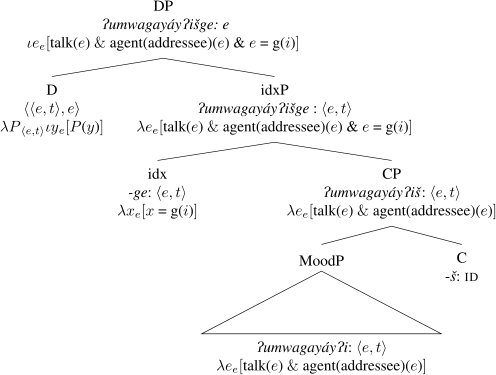
Note that the meaning of the index here is the same as it is in familiar definites, rather than the binder meaning of matrix idx in internally headed relatives.Footnote 40 That is, it has the meaning in (107a) rather than (107b). I argue that this is the desired result: The purpose of the variable here is to refer to an event previously mentioned in the linguistic context, or otherwise made available in the perceivable surroundings.
-
(107)

Note that if idx were assigned the meaning in (107b) in a perception nominalization such as (106), the derivation would crash: There is no free variable within the CP, and so the Prohibition against Vacuous Binding would be violated. The need for a variable meaning of idx in the latter construction therefore supports the polysemous view of -gi/-ge, according to which it may act as a binder (in IHRCs) or as a variable (perception readings), even within the same syntactic configuration.
6 Deriving the exponence of idx
The final section of this paper addresses the morphological realization of the morpheme gi/ge, which I argue to have both a covert and overt realization. After considering the distribution of this morpheme, I put forward an account of Washo according to which idx is pronounced unless it has an overt nominal complement. This proposal explains the lack of pronunciation of idx in anaphoric bare definites and in IHRC-internal quantified expressions. A potential problem for this account from demonstratives is also introduced and then ruled out.
6.1 The distribution of gi/ge
The morpheme gi/ge surfaces in three types of constructions in Washo: i) independent third person pronominal forms (108); ii) demonstratives (109); and iii) clausal nominalizations including internally headed relatives and perception readings (110).
-
(108)

-
(109)

-
(110)

To account for the range of environments in which gi/ge occurs, I argue that the presence of this morpheme is indicative of a (largely) uniform syntax, and that definite descriptions share the underlying structure in (111). The key difference is the complement of idx: In the case of pronouns and anaphoric bare definites, idx selects for an NP complement. In clausal nominalizations, it selects for a CP instead.
-
(111)
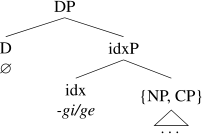
As exemplified by anaphoric bare definites such as (112) however, idx is not always overtly realized at PF. Given the proposed implementation of familiar definites à la Schwarz (2009), idx is required to be present in the structure in (111) to achieve the correct interpretation, but is clearly not pronounced.
-
(112)

If gi/ge is an allomorph of idx, then its appearance must be regulated by certain rules for exponence that explain its distribution. Setting the demonstrative aside for now, the generalization from the data above is that idx is overtly realized just in case it lacks an overt nominal complement, and is therefore subject to a rule of contextual allomorphy (see, e.g., Bonet and Harbour 2012 for a recent overview). This explains why idx is overtly realized in the case of independent pronouns, as in (108), as well as in the case of clausal nominalizations such as IHRCs (110). As schematized below, the nominal restriction in pronouns is null (113), while in clausal nominalizations, the complement of idx is a CP, rather than an NP (114). In neither case does idx take an overt NP complement, and idx is overtly realized.
-
(113)

-
(114)

The shared characteristic of both of these environments is that no overt nominal is present. This stands in contrast to instances of anaphoric definites without gi/ge, as in (115) (cf. (112)), in which the nominal restriction is always overt.
-
(115)

Central to this proposal is that independent pronouns contain more structure than is seen on the surface, as in (113), and relatedly that idx is sensitive to whether an NP is overt or covert; I turn to this issue in the next subsection.
6.2 Pronouns as definite descriptions in disguise
One of the core questions addressed in the literature on the structural nature of indices is whether pronominal expressions can be taken to be instantiations of a larger (covert) DP structure in the same way that fully-fledged definite descriptions can. For instance, based on data such as (116), in which a pronoun may occur alongside an overt nominal, Elbourne (2005) argues that pronouns can act as determiners in their own right, building on claims put forward in Postal (1966) and Lyons (1999) (see also Sauerland 2007; Elbourne 2013; Hinterwimmer 2015; Patel-Grosz and Grosz 2017).
-
(116)
We Americans distrust you Europeans.
Elbourne’s proposal is that pronouns and definite descriptions share an identical structure, schematized in (117), in which the pronoun is merely an allomorph of D.
-
(117)

I argue here that pronouns in Washo are definite descriptions in disguise, in the spirit of Elbourne (2005, 2008) (see also Patel-Grosz and Grosz 2017 for German, Bi and Jenks 2019 for Mandarin). Unlike Elbourne, however, I propose that the pronoun is not an allomorph of the definite article, but is instead an allomorph of idx that is selected by a D head. In order to account for the sensitivity of idx to the lack of an overt nominal complement in independent pronouns (113), I adopt the idea that the NPs housed inside definite descriptions pronounced as pronouns at PF have undergone nominal ellipsis (Elbourne 2005), which can be described as PF deletion of a nominal projection (see Hankamer and Sag 1976; Saab 2008; Merchant 2014a). According to Elbourne, the pronoun is obligatorily spelled out as the definite article in cases when an overt nominal is present. In Washo, the result is similar: The presence of the overt nominal bars the overt realization of the idx head gi/ge. In standard treatments of nominal ellipsis, noun phrases that have been elided bear an e-feature: this feature is what targets the entire phrase for deletion at PF (Merchant 2001). The presence of this e-feature is relevant for the rules of vocabulary insertion, to follow. (Motivation for the proposal that pronouns contain an elided NP follows in Sect. 6.3).
The proposal here is couched in the realizational framework of Distributed Morphology (Halle and Marantz 1993). In this framework, terminal nodes are the only parts of the structure that are targetable for vocabulary insertion, which occurs in the postsyntactic component of the grammar. Contextual allomorphy occurs at the stage of vocabulary insertion which is the final step after all other hierarchical and linear operations are complete (Arregi and Nevins 2012a). During vocabulary insertion, morphological features on each terminal node are matched with the proper vocabulary entry, which is determined by the Subset Principle (Halle 1997): The vocabulary entry that is chosen for exponence is the one that realizes the maximal subset of morphosyntactic features present on the terminal node itself, and which hosts no features that are not present on the terminal node. According to the Subset Principle (118), the most specific vocabulary entry available for a given feature set is inserted in accordance with the Elsewhere Principle.
-
(118)
Subset Principle
-
a.
Underspecification: the exponent in a vocabulary entry is eligible for insertion into a terminal node if the entry’s morphological feature structure is a subset of the features in the terminal node, and if the contextual restriction of the former is compatible with the context of the latter.
-
b.
Elsewhere Principle: where several entries meet Underspecification, the one matching the greatest number of features in the terminal node must be chosen.
-
c.
Contextual Specificity: where several entries meet the Elsewhere Principle, the one with the most specific contextual restriction must be chosen.
-
a.
Following Arregi and Nevins (2012a,b), I assume that contextual specificity takes precedence over the Elsewhere Principle. This means that any contextual restrictions are taken into account first, with the result that a contextual restriction will override less-specified vocabulary entries if they could otherwise apply. With this in mind, the vocabulary entries in (119) (=(38)) account for the distribution of gi/ge in Washo. (119a) captures the status of gi as the elsewhere form. (119b) states that ge must be inserted if idx bears a dependent case feature. Finally, (119c) provides a contextually-restricted rule: idx is null in case its complement is an (overt) NP.
-
(119)
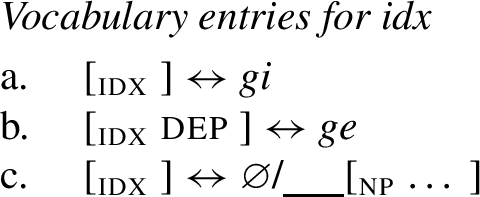
Note importantly that the rule in (119c) will also apply within the quantifier phrase in cases where the DP it selects contains idx, as idx in such cases likewise has an overt nominal complement (e.g., IHRC-internal míʔlew gawá:yɨʔ in (98)).
6.3 Pronouns and nominal ellipsis
In order to count as an overt NP for the purposes of vocabulary insertion, the nominal restriction must have phonological features. In cases where nominal ellipsis has taken place, the E-feature is then what signals a lack of such features, as it signals that all material following it must not be pronounced. This makes the rule in (119c) incompatible with the vocabulary entry for idx in, e.g., pronouns. Support for Elbourne’s proposal that pronouns may contain a nominal layer comes from the behavior of morphological concord in Washo. In Washo, independent pronouns inflect only for number in Washo (Table 1), repeated here in Table 2.
Number is therefore readily expressed on independent pronouns, as in (120):
-
(120)
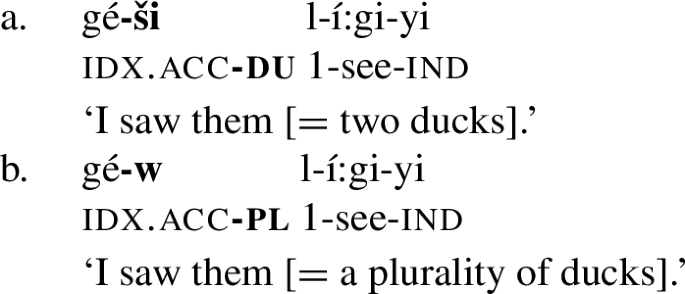
Crucially, these number suffixes are precisely the same suffixes that are found on nominal modifiers in the language. While Washo lacks gender distinctions across the board, it does exhibit concord for number in the modification of animate nouns. This can be expressed either by the dual suffix -ši (121) or the plural suffix -w (122). Note that while plural on (many) animate nouns is marked by internal reduplication (see Yu 2005) as in (121a) below (sg. t’é:liwhu → pl. t’elí:liwhu), it is otherwise not expressed on the nominal at all, as in (122a) (sg./pl. dílek).
-
(121)

-
(122)
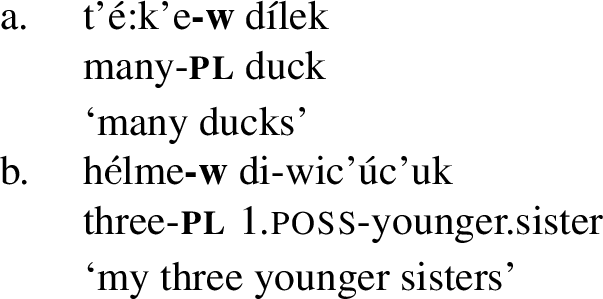
The number (and person) features on the pronoun can be explained if a covert nominal phrase supplies φ-feature information. For example, under the system of concord proposed by Norris (2014), φ-features are collected on D and then copied onto dedicated Agr nodes, which are inserted postsyntactically. Take the example in (123):
-
(123)

In (123), the elided NP can be represented as dílek ‘ducks’, which bears both 3rd person and dual features in this context.Footnote 41 In Norris’s account, the first step in nominal concord is to collect all features of N on DP in the syntax, as shown in (124):
-
(124)
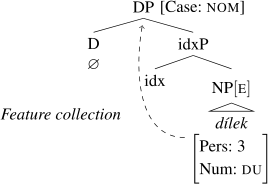
Agr node insertion applies, as defined as in (125): A dissociated morpheme Agr is inserted at each (language specific) concord-bearing head at PF.
-
(125)

After feature collection, the pool of features is then copied onto these Agr nodes postsyntactically, resulting in a configuration such as in (126), after which point Agr is morphologically realized as the dual suffix -ši on the pronoun, and dílek goes unpronounced due to the presence of the e-feature.Footnote 42
-
(126)

6.4 The structure of demonstratives
The proposal as presented in Sect. 5.2 does not appear at first glance to extend to demonstratives. Following the rules for vocabulary insertion in (38), idx should not be overtly realized due to the fact that it appears to take a nominal complement, as shown in the examples in (127):
-
(127)

As described in Sect. 2.2 however, the structure of demonstratives is more complex than that of simple anaphoric definites: The functional projection RP is likewise present in such cases, leading to the following contrast:
-
(128)
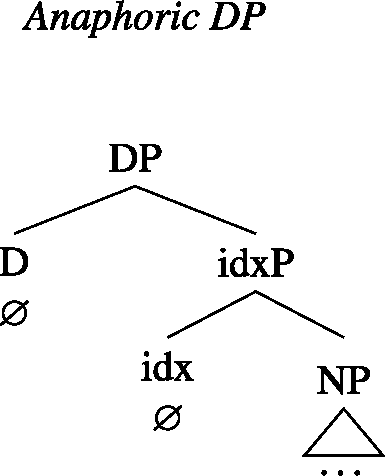
-
(129)
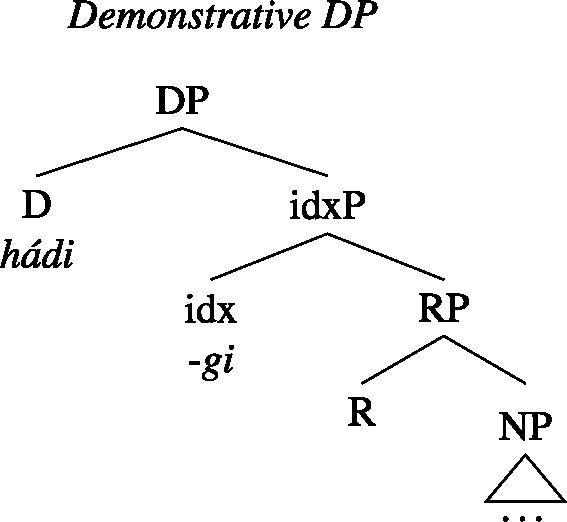
Crucially, the criteria for the pronunciation of idx is met in (129): The complement of idx is not NP, but RP. Now taking demonstratives into account, we arrive at the following set of vocabulary insertion rules. The elsewhere form of the definite article is null, (130a), while D heads specified with deictic features are spelled out with dedicated vocabulary entries (130b-c). The vocabulary insertion rules for idx remain the same as above (119), and are repeated in (131).
-
(130)
Vocabulary entries for D
-
a.
[ D ] → ∅
-
b.
[ D distal] ↔ hádi
-
c.
[ D proximal] ↔ wídi
-
a.
-
(131)
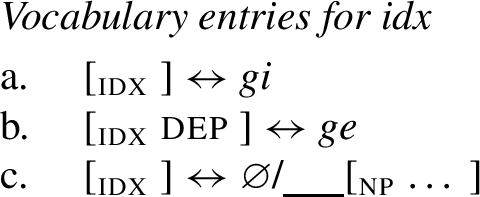
The analysis presented in this section offers a unified view of the Washo DP according to which pronouns, demonstratives, anaphoric bare definites and internally headed relatives all host an index within their structure. The realization of idx as gi/ge is regulated moreover by rules for vocabulary insertion that take the presence of an overt NP in the context into consideration. When an overt NP is present, idx is not pronounced, explaining why it is not overtly realized in anaphoric bare definites.
7 Conclusion
This view from Washo lends novel evidence to the set of proposals that indices are syntactic objects—separate from D—encoded by idx in the structure of familiar definites. I have argued that the morpheme gi/ge is the overt realization of idx, as revealed by the morphology of pronouns and demonstratives. Washo therefore bolsters previous semantic claims about the nature of indices by wearing its morphology on its sleeve, and provides a direct parallel of overt realization to the indirect evidence for indices provided by i.a. Schwarz (2009) for a language such as German.
The presence of idx in internally headed relatives bolsters moreover a syntactic treatment of indices by showing that idx can encode not only a variable meaning, as previously proposed, but also that of a variable binder: two semantic functions independently expected of indices. Investigation of island-insensitive IHRCs in a language like Washo moreover sheds light on the correlation between the DP status of a given language and the way in which it derives relative clauses. The proposed analysis extends also to perception readings, another type of clausal nominalization involving a DP-layer, and likewise explains the violation of the indefiniteness restriction.
Finally, the exponence of idx reveals a sensitivity to the presence of an overt NP. The presence of such an NP triggers non-pronunciation of idx, explaining its lack of pronunciation in bare definites containing idx. The resulting generalizations allow for a unified picture of definite descriptions in Washo in which pronouns, demonstratives, bare definites, and clausal nominalizations share a common underlying structure.
In sum, the evidence from Washo supports the view that indices are not merely notational devices, but must instead be taken seriously as syntactic objects that may be overtly realized by dedicated morphology. This is a welcome result, as the proposal that anaphoric or familiar DPs contain ‘extra’ structure in the form of an index predicts that we should find evidence for this structure in anaphoric DPs—a prediction that is transparently borne out by the effects of idx in Washo.
Notes
The morpheme gi/ge alternates for case; I return to this in Sect. 2.2.
Glosses: acc: accusative; dep: dependent mood; dist: distal; ds: different subject; du: dual; dur: durative; imp: imperative; ind: independent mood; inst: instrumental; int.pst: intermediate past; nc: negative concord; neg: negation; nom: nominative; obl: oblique; pl: plural; prosp: prospective aspect (Bochnak 2016); prox: proximal; r: reduplication; refl: reflexive; stat: static; ss: same subject; q: question particle. The numbers 1, 2, and 3 represent 1st, 2nd, and 3rd person, respectively. A prefixed number represents intransitive subject agreement in verbs and possessor agreement in nouns. Transitive verbs have a portmanteau prefix indicating the person of the subject and object, represented as 1/2 (‘one-on-two’), 3/1 (‘three-on-one’), etc. The orthography adopted is from Jacobsen (1964). Symbols deviating from the IPA are: c
 ; M
; M  ; š [ʃ]; y [j]; acute accents over vowels represent stressed syllables.
; š [ʃ]; y [j]; acute accents over vowels represent stressed syllables.Schwarz’s proposal uses Kratzer’s (1989) situation semantics; situation variables are omitted here.
As a reviewer points out, this decompositional view of anaphoricity is perhaps less straightforward when it comes to languages making use of two distinct article paradigms for anaphoric and non-anaphoric determiners (e.g. Fering, Ebert 1971a,b). One potential solution would be one invoking contextual allomorphy, treating the non-anaphoric determiner as the default, and the anaphoric form as an allomorph triggered in the context of a local index. The same reviewer points out that this index must still be subject to something along the lines of Heim’s (1982) Familiarity Constraint, requiring that the referent be discourse old, in the case of anaphora.
See Gillon (2015) for more on testing for definiteness in a fieldwork setting.
In Hawkins’ (1978) terminology, this counts as a ‘global situation’ use of the definite.
A reviewer points out that an important piece of data here is the behavior of donkey anaphora, which require an indexed definite (Schwarz 2009; Schlenker 2017; Jenks 2018). If Washo allows bare definites in donkey anaphora, this would provide evidence that they occur with a silent index. I unfortunately do not have such data on donkey anaphora at this time, and have to leave this question for future work.
A reviewer also points out that evidence for null indices in bare definites might be drawn from the unavailability of demonstratives in anaphora (‘discourse demonstratives’; Roberts 2002). As far as I am aware, demonstratives in Washo are limited to deictic uses.
The morpheme gi/ge is only long and stressed when used as an independent form as in (26). Otherwise (i.e., when used as a suffix) it is short and unstressed.
A reviewer raises the question of how to tell whether a language realizes idx in the face of homophony and diachronic change. I clarify here that I do not propose that Washo is unique in containing idx, but only that its morphology is transparent. The structure of demonstratives in a given language must be based on language-specific investigation.
Diverging from Elbourne (2005), I place the proximal vs. distal distinction observed in demonstratives as presuppositions on D. For example, as a reviewer points out, in an example such as (34), the proximity of the former apple to the speaker cannot be denied, much like its (presupposition of) existence cannot be. See Roberts (2002) for more on presuppositions carried by demonstratives.
-
(i)
It’s not this apple, it’s that one!
-
(i)
I henceforth gloss gi/ge as idx.
Jacobsen (1998) refers to internally headed relatives as ‘headless’ relatives, but IHRCs are not to be confused with truly headless relatives in the language, which are IHRCs with an unpronounced argument.
I follow traditional terminology by referring to the ‘semantic head’ of the relative clause, where ‘head’ is used in a non-syntactic sense and merely refers to the relativized argument. See, e.g., Basilico (1996).
Broadly stated, Arregi and Hanink’s (2018) analysis is that this C head agrees downward for the referential index value of the embedded subject, and upward for the referential index value of the superordinate subject. Morphological rules determine that C is realized with the same subject marker when these indices match, and with the different subject marker when they do not, a situation giving rise to feature conflict.
A reviewer questions why idx never lowers to any head but C. There is a potential diachronic explanation from clausal reanalysis: Givón (2015) outlines a diachronic process in which a finite clause is converted to a nominal, requiring a shift to a single intonational contour that would not be possible if, e.g., -gi/-ge were a stand-alone pronoun (see also Mithun 2007). I thank Adam Singerman for pointing this out.
Jacobsen (1977) refers to these forms as ‘subjective’ and ‘objective,’ respectively.
There are a range of tests for D that are independent of internally headed relatives. While some of these are difficult to test in Washo due to its SOV word order, Washo also passes e.g., Norris’s (2018) test for the availability of wh-determiners (55b), as highlighted by the position of the q morpheme.
-
(i)
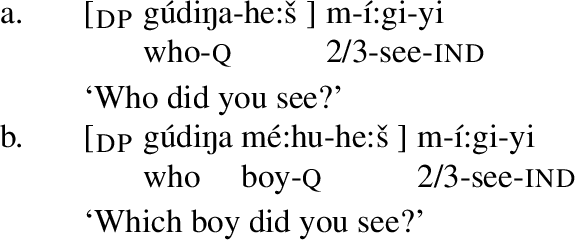
-
(i)
Related treatments of pronouns are found, e.g., in Condoravdi (1989), in Heim’s (1982) treatment of indefinite wh-pronouns, Sauerland’s (2003) content specified traces on the matching analysis of relative clauses, and Sauerland’s (2004) treatment of copies. Relevant here is Condoravdi’s (1989) proposal that pronouns are similar to bare nouns in languages lacking overt definite/indefinite articles, in that they may be interpreted either as definites or indefinites. See Condoravdi (1989:77) for discussion.
A further specification is required here, which is to prevent \(g(i_{\mathit{coyote}})\) from being a current discourse referent. See discussion in Alonso-Ovalle (2002).
A reviewer raises the question of how the semantic head composes with the verb. On the current view, because an indefinite is interpreted as a restricted variable, it is simply of type e (like other variables). For the same treatment in internally headed relatives see Basilico (1996:507) and Toosarvandani (2014:812).
I note here that there are also cases in Washo where we want two instances of idx to occur. In e.g., stacking cases, the presence of an additional, variable-denoting idx on top of the binder-denoting idx will introduce another variable into the meaning of the lower relative clause that can be targeted for binding by the higher one, see e.g. Hanink (2016).
A reviewer asks whether pronouns can serve as the head of an IHRC, correctly pointing out that this should be possible if the meaning of pronoun contains a (bindable) index. I unfortunately do not have such data available at the present time.
An important question here is what makes long distance binding possible (or indeed what drives it) in a given language. For instance, some languages lack Ā-movement in relative clauses but exhibit Ā-effects in wh-constructions (e.g., Quechua, Cole and Hermon 1994). See also Watanabe (2002) for a proposed parametrization of determiners.
A reviewer raises the related question of whether a demonstrative can co-occur with an internally headed relative, given the claim that the latter contain a D head that could in principle be occupied by hádi/wídi. To the best of my knowledge, this is not possible.
This meaning is for the distributive reading of all, but can be modified to account for cumulative readings of the universal quantifier.
A reviewer points out the prediction that the universal quantifier in such cases should not take scope over other quantifiers, e.g., an existential, in the matrix clause. I unfortunately do not have data points illustrating this at this time.
The facts are similar for Korean; see Kim (2009) for an analysis based on an e-type anaphora account of IHRCs.
As a reviewer points out, the index here will need to show flexibility in whether it can map to an individual or an event. This is at least consistent with the treatment of individuals and events as the same type, an assumption I adopt here.
A reviewer has raised the question of whether the pro-drop behavior of Washo correlates with distinctions in definiteness. For example, Bi and Jenks (2019) report for Mandarin that null pronouns are used in unique contexts, while overt pronouns are used in anaphoric ones (see also Kurafuji 1998; Barbosa 2019). This is not the case in Washo, as exemplified through the availability of an overt pronoun in both subject (126) and object (127) position in anaphoric contexts. There is however a sense that the use of the overt pronoun is associated with a stronger meaning, used for emphasis or contrast, in a way that is not necessarily reducible to whether its use is anaphoric or not. The overt pronoun is also used in cases where an oblique meaning is required, encoded through the presence of a postposition (iii). There are undoubtedly a variety of factors governing the appearance of overt pronouns, but I leave this issue for future work.
-
(i)

-
(ii)

-
(iii)

-
(i)
References
Abney, Steven. 1987. The English noun phrase in its sentential aspect. PhD diss., MIT.
Adger, David, and Gillian Ramchand. 2005. Merge and move: Wh-dependencies revisited. Linguistic Inquiry 36: 161–193.
Alonso-Ovalle, Luis. 2002. Arbitrary pronouns are not that indefinite. In Romance languages and linguistic theory, eds. Frank Drijkoningen, Claire Beyssade, Reineke Bok-Bennema and Paola Monachesi, 1–15. Amsterdam: Benjamins.
Arkoh, Ruby, and Lisa Matthewson. 2013. A familiar definite article in Akan. Lingua 123: 1–30.
Arregi, Karlos, and Emily A. Hanink. 2018. Switch reference in Washo as multiple subject agreement. In North East Linguistic Society (NELS) 48, eds. Sherry Hucklebridge and Max Nelson, Vol. 1, 39–48. Amherst: GLSA Publications.
Arregi, Karlos, and Andrew Nevins. 2012a. Contextual neutralization and the Elsewhere Principle. In Distributed Morphology today, 199–221. Cambridge: MIT Press.
Arregi, Karlos, and Andrew Nevins. 2012b. Morphotactics: Basque auxiliaries and the structure of spellout. Dordrecht: Springer.
Barbosa, Pilar P. 2019. Pro as a minimal nP: Toward a unified approach to pro-drop. Linguistic Inquiry 50.3: 487–526.
Barss, Andrew, Kenneth Hale, Ellavina Perkins, and Margaret Speas. 1990. Logical form and barriers in Navajo. In Logical form: Cross-linguistic perspectives, eds. C. T. Huang and Robert May, 25–47. Dordrecht: Kluwer.
Basilico, David. 1996. Head position and internally headed relative clauses. Language 24: 498–532.
Bhatt, Rajesh. 2002. The raising analysis of relative clauses: Evidence from adjectival modification. Natural Language Semantics 10.1: 43–90.
Bi, Ruyue Agnes, and Peter Jenks. 2019. Pronouns, null arguments, and ellipsis in Mandarin Chinese. In Sinn und Bedeutung 23, eds. M. Teresa Espinal, Elena Castroviejo, Manuel Leonetti, Louise McNally, and Cristina Real-Puigdollers, 127–142.
Bianchi, Valentina. 1995. Consequences of antisymmetry: Headed relative clauses. Berlin: de Gruyter.
Bochnak, M. Ryan. 2016. Past time reference in a language with optional tense. Linguistics and Philosophy 39: 247–294.
Bogal-Allbritten, Elizabeth, and Keir Moulton. 2017. Navajo in the typology of internally-headed relatives. In Semantic and Linguistic Theory (SALT) 27, eds. Dan Burgdorf, Jacob Collard, Sireemas Maspong and Brynhildur Stefánsdóttir, 700–720. Washington: Linguistic Society of America.
Bonet, Eulàlia, and Daniel Harbour. 2012. Contextual allomorphy. In The morphology and phonology of exponence, ed. Jochen Trommer, 195–235. Oxford: Blackwell.
Bonneau, Jose. 1992. The structure of internally headed relative clauses. PhD diss., McGill University.
Bošković, Željko. 2008. What will you have, DP or NP? In North East Linguistic Society (NELS) 37, eds. Emily Elfner and Martin Walkow, Vol. 1, 101–114. Amherst: GLSA Publications.
Bošković, Željko. 2009. More on the no-DP analysis of article-less languages. Studia Linguistica 63.2: 187–203.
Bošković, Željko, and I-Ta Chris Hsieh. 2015. On the semantics of the NP-internal word order: Chinese vs Serbo-Croatian. In Slavic languages in the perspective of formal grammar: The proceedings of formal description of Slavic languages 10.5, Brno, 101–120. Warsaw: Peter Lang.
Boyle, John P. 2016. The syntax and semantics of internally headed relative clauses in Hidatsa. In Advances in the study of Siouan languages and linguistics, eds. Catherine Rudin and Bryan J. Gordon, 255–287. Berlin: Language Science Press.
Brame, Michael. 1968. A new analysis of the relative clause: Evidence for an interpretive theory. Ms., MIT.
Broadwell, George Aaron. 1985. Internally headed relative clauses in Choctaw. Kansas Working Papers in Linguistics 6: 16–24.
Broadwell, George Aaron. 1987. A-bar anaphora and relative clauses. In North East Linguistic Society (NELS) 16, 47–56. Amherst: GLSA.
Campbell, Lyle. 1997. American Indian languages: The historical linguistics of native America. London: Oxford University Press.
Caponigro, Ivano. 2004. The semantic contribution of wh-words and type shifts: Evidence from free relatives crosslinguistically. In Semantics and Linguistic Theory (SALT) 14, ed. Robert B. Young, 38–55. Ithaca: CLC Publications.
Chomsky, Noam. 1981. Lectures on government and binding. Dordrecht: Foris.
Chomsky, Noam. 2000. Minimalist inquiries: The framework. In Step by step: Essays on minimalist syntax in honor of Howard Lasnik, eds. Roger Martin, David Michaels, and Juan Uriagereka, 89–155. Cambridge: MIT Press.
Chomsky, Noam. 2001. Derivation by phase. In Ken Hale: A life in language, ed. Michael Kenstowicz, 1–52. Cambridge: MIT Press.
Cieschinger, Maria. 2006. Constraints on the contraction of preposition and definite article in German. B.A. Thesis, Universität Osnabrück.
Citko, Barbara. 2004. On headed, headless, and light-headed relatives. Natural Language and Linguistic Theory 22.1: 95–126.
Cole, Peter. 1987. The structure of internally headed relative clauses. Natural Language and Linguistic Theory 5(2): 277–302.
Cole, Peter, and Gabriella Hermon. 1994. Is there LF wh-movement? Linguistic Inquiry 25: 239–262.
Condoravdi, Cleo. 1989. Indefinite and generic pronouns. In West Coast Conference on Formal Linguistics (WCCFL) 8, eds. Jane Fee and Kathryn Hunt, 71–84. Stanford: CSLI Publications.
Culy, Christopher. 1990. The syntax and semantics of IHRCs. PhD diss., Stanford University.
Dayal, Veneeta. 1991a. Wh-dependencies in Hindi and the theory of grammar. PhD diss., Cornell University.
Dayal, Veneeta. 1991b. The syntax and semantics of correlatives. Natural Language and Linguistic Theory 9: 637–686.
Dayal, Veneeta. 2004. Number marking and (in)definiteness in kind terms. Linguistics and Philosophy 27: 393–450.
Deal, Amy Rose. 2017. Towards an etiology of outer indices. In A schrift to fest Kyle Johnson, eds. Nicholas LaCara, Keir Moulton, and Anne-Michelle Tessier. Vol. 1 of Linguistics open access publications. 107–117.
Ebert, Karin. 1971a. Referenz, Sprechsituation und die bestimmten Artikel in einem Nordfriesischen Dialekt (Fering). PhD diss., Christian-Albrechts-Universität zu Kiel.
Ebert, Karin. 1971b. Zwei Formen des bestimmten Artikels. In Probleme und Fortschritte der Transformationsgrammatik, ed. Dieter Wunderlich, 159–174. München: Hueber.
Elbourne, Paul. 2005. Situations and individuals, Vol. 90. Cambridge: MIT Press.
Elbourne, Paul. 2008. Demonstratives as individual concepts. Linguistics and Philosophy 31.4: 409–466.
Elbourne, Paul. 2013. Definite descriptions. Oxford studies in semantics and pragmatics 1. London: Oxford University Press.
Elliott, Patrick. 2016. Explaining DPs vs. CPs without syntax. In Chicago Linguistic Society (CLS) 52, eds. Jessica Kantarovich, Tran Truong and Orest Xherija, 171–185. Chicago Linguistic Society.
Embick, David. 2010. Localism versus globalism in morphology and phonology, Vol. 60. Cambridge: MIT Press.
Embick, David, and Rolf Noyer. 2001. Movement operations after syntax. Linguistic Inquiry 32.4: 555–595.
Fiengo, Robert, and Robert May. 1994. Indices and identity. Cambridge: MIT Press.
Finer, Daniel L. 1985. The syntax of switch-reference. Linguistic Inquiry 16(1): 35–55.
Giannakidou, Anastasia. 2009. The dependency of the subjunctive revisited: Temporal semantics and polarity. Lingua 119: 1883–1908.
Gillon, Carrie. 2015. Investigating D in languages with and without articles. In Methodology in semantic fieldwork, eds. M. Ryan Bochnak and Lisa Matthewson, 175–205. Oxford: Oxford University Press.
Givón, Talmy. 2015. The Handbook of language emergence. In The diachronic genesis of synchronic syntax, eds. Brian MacWhinney and William O’Grady, 201–214. Hoboken: John Wiley.
Grimshaw, Jane B. 2005. Words and structure. Center for the Study of Language and Information, Stanford University.
Grosu, Alexander. 2002. Strange relatives at the interface of two millennia. Glot International 6.6: 145–167.
Grosu, Alexander. 2012. Towards a more articulated typology of internally headed relative constructions: the semantics connection. Language and Linguistics Compass 7: 447–476.
Grosu, Alexander, and Fred Landman. 1998. Strange relatives of the third kind. Natural Language Semantics 6.2: 125–170.
Grosz, Patrick. 2015. Movement and agreement in right-node raising constructions. Syntax 18: 1–38.
Grove, Julian, and Emily Hanink. 2016. Article selection and anaphora in the German relative clause. Semantics and Linguistic Theory (SALT) 26, eds. M. Moroney, C.R. Little, J. Collard and D. Burgdorf, 417–432.
Haberland, Hartmut. 1985. Zum Problem der Verschmelzung von Präposition und bestimmtem Artikel im Deutschen. Osnabrücker Beiträge zur Sprachtheorie 30.
Halle, Morris. 1997. Impoverishment and fission. In PF: Papers at the interface, eds. Benjamin Bruening, Yoonjung Kang, and Martha McGinnis, 425–450. Cambridge: MIT Working Papers in Linguistics.
Halle, Morris, and Alec Marantz. 1993. Distributed Morphology and the pieces of inflection. The view from building 20.
Hanink, Emily. 2016. Internally headed relatives and event nominalizations in Washo. In Berkeley Linguistics Society (BLS) 42, E. Clem, V. Dawson, Al. Shen, A.H. Skilton, G. Bacon, A. Cheng and E.H. Maier, 119–134. Berkeley: UC.
Hanink, Emily. 2017. The German definite article and the ‘sameness’ of indices. In Penn working papers in linguistics, eds. Kajsa Djärv and Amy Goodwin Davies, Vol. 23.1. Philadelphia: University of Pennsylvania.
Hanink, Emily. 2018. Structural sources of Anaphora and Sameness. PhD diss., University of Chicago.
Hanink, Emily, and M. Ryan Bochnak. 2018. Factivity and two types of embedded clauses in Washo. In North East Linguistic Society (NELS) 47, eds. A. Lamont and K. Tetzlof, 65–78. Amherst: GLSA Publications.
Hanink, Emily, and Julian Grove. 2017. German relative clauses and the severed index hypothesis. In West Coast Conference on Formal Linguistics (WCCFL) 34, eds. Aaron Kaplan, Abby Kaplan, Miranda K. McCarvel, and Edward J. Rubin, 241–248. Somerville: Cascadilla Proceedings Project.
Hankamer, Jorge, and Ivan A. Sag. 1976. Deep and surface anaphora. Linguistic Inquiry 7: 391–426.
Hartmann, Dietrich. 1978. Verschmelzungen als Varianten des bestimmten Artikels? In Sprache in Gegenwart und Geschichte. Festschrift Für Heinrich Matthias Heinrichs, eds. Hans-Jürgen Linke Dietrich Hartmann and Otto Ludwig, 68–81. Köln: Böhlau.
Hartmann, Dietrich. 1980. Über Verschmelzungen von Präposition und bestimmtem Artikel. Untersuchungen zu ihrer Form und Funktion in gesprochenen und geschriebenen Varietäten des heutigen Deutsch. Zeitschrift für Dialektologie und Linguistik 47.2: 160–183.
Hastings, Rachel. 2004. The syntax and semantics of relativization and quantification: The case of Quechua. PhD diss., Cornell University.
Hawkins, John A. 1978. Definiteness and indefiniteness: A study in reference and grammaticality prediction. London: Croom Helm.
Heim, Irene. 1982. The semantics of definite and indefinite noun phrases. PhD diss., UMass Amherst.
Heim, Irene. 1998. Anaphora and semantic interpretation: A reinterpretation of Reinhart’s approach. In MIT working papers in linguistics, eds. Uli Sauerland and Orin Percus, Vol. 25, 205–246. Cambridge: MIT Press.
Heim, Irene, and Angelika Kratzer. 1998. Semantics in generative grammar, Vol. 13. Oxford: Blackwell.
Hicks, Glyn. 2009. The derivation of anaphoric relations. Amsterdam: Benjamins.
Higgenbotham, James. 1983. Logical form, binding, and nominals. Linguistic Inquiry 14: 395–420.
Hinterwimmer, Stefan. 2015. A unified account of the properties of German demonstrative pronouns. In NELS semantics workshop on pronouns, eds. Patrick Grosz, Pritty Patel-Grosz, and Igor Yanovich, 61–107. Amherst: GLSA Publications.
Hoshi, Koji. 1995. Structural and interpretive aspects of head-internal and head-external relative clauses. PhD diss., University of Rochester.
Jacobsen, William. 1964. A grammar of the Washo language. PhD diss., UC Berkeley.
Jacobsen, William. 1967. Switch-reference in Hokan-Coahuiltecan. In Studies in southwestern linguistics, eds. Dell Hymes and William Bittle, 238–263. The Hague: Mouton.
Jacobsen, William. 1977. A glimpse of the pre-Washo pronominal system. In Berkeley Linguistics Society (BLS) 3, ed. Kenneth Whistler et al., 55–73. Berkeley Linguistics Society.
Jacobsen, William. 1998. Headless relative clauses in Washo. In Studies in American Indian languages: Description and theory, eds. Leanne Hilton and Pamela Munro, 102–116. Berkeley: University of California Press.
Jelinek, Eloise. 1987. Headless relatives and pronominal arguments: A typological perspective. In Native American Languages and grammatical typology. Papers from a CLS parasession, eds. D. Kroeber and R.E. Moore, IULC Bloomington.
Jenks, Peter. 2018. Articulated definiteness without articles. Linguistic Inquiry 49.3: 501–536.
Johnson, Kyle. 2007. In search of phases. In Phrasal and clausal architecture, eds. Simin Karimi, Vida Samiian, and Wendy Wilkins, 146–166. Amsterdam: Benjamins.
Kamp, Hans. 1981. A theory of truth and semantic representation. In Formal methods in the study of language: The Proceedings of the third Amsterdam colloquium, eds. J. Groenendijk, T. Janssen, and M. Stokhof, Vol. I, 227–321. Amsterdam: Mathematical Center.
Kaplan, David. 1989. Demonstratives: An essay on the semantics, logic, metaphysics, and epistemology of demonstratives and other indexicals. In Themes from Kaplan, eds. Joseph Almog, John Perry, and Howard Wettstein. Oxford: Oxford University Press.
Kayne, Richard. 1994. The antisymmetry of syntax. Cambridge: MIT Press.
Kennedy, Chris. 2004. Argument contained ellipsis. In Topics in ellipsis, 95–131. Cambridge: Cambridge University Press.
Kennedy, Chris. 2014. Predicates and formulas: Evidence from ellipsis. In The art and craft of semantics: A festschrift for Irene Heim, eds. Luka Crnič and Uli Sauerland, Vol. 1, 83–136. MITWPL.
Kim, Min-Joo. 2009. E-type anaphora and three types of kes-construction in Korean. Natural Language and Linguistic Theory 27: 345–377.
King, Jeffrey. 2001. Complex demonstratives: A quantificational account. Cambridge: MIT Press.
Klecha, Peter, and Martina Martinović. 2015. Exhaustivity, predication and the semantics of movement. Berkeley Linguistics Society (BLS) 41, eds. Anna E. Jurgensen, Hannah Sande, Spencer Lamoureux, Kenny Baclawski and Alison Zerbe.
Kobele, Greg. 2006. Generating copies: An investigation into structural identity in language and grammar. PhD diss., UCLA.
Kobele, Greg. 2010. Inverse linking via function composition. Natural Language Semantics 18: 183–196.
Kramer, Ruth. 2016. A split analysis of plurality: Number in Amharic. Linguistic Inquiry 47.3: 527–559.
Kratzer, Angelika. 1989. An investigation in the lumps of thought. Linguistics and Philosophy 12(5): 607–653.
Kratzer, Angelika. 1996. Severing the external argument from its verb. In Phrase structure and the lexicon, eds. Johan Rooryck and Laurie Zaring. Studies in natural language and linguistic theory, 109–137. Boston: Kluwer Academic Publishers.
Kratzer, Angelika. 2009. Making a pronoun: Fake indexicals as windows into the properties of pronouns. Linguistic Inquiry 40.2: 187–237.
Kurafuji, Takeo. 1998. Dynamic Binding and the E-type strategy: Evidence from Japanese. In Semantic and Linguistic Theory (SALT) 8, eds. Devon Strolovitch and Aaron Lawson. Studies in natural language and linguistic theory, 129–144. Washington: Linguistic Society of America.
Langdon, Margaret. 1977. Syntactic change and SOV structure. In Mechanisms of syntactic change, ed. Charles N. Li, 255–290. Austin: University of Texas Press.
Langdon, Margaret, and Pamela Munro. 1979. Subject and (switch-) reference in Yuman. Folia Linguistica 13.3-4: 321–344.
Lefebvre, Claire, and Pieter Muysken. 1988. Mixed categories: Nominalization in Quechua. Dordrecht: Kluwer.
Link, Godehard. 1983. The logical analysis of plurals and mass terms: A lattice theoretical approach. In Meaning, use, and the interpretation of language, eds. Rainer Bäuerle, Christoph Schwarze, and Arnim vonStechow, 302–323. Berlin: de Gruyter.
Longobardi, Giuseppe. 1994. Reference and proper names: A theory of N-movement in syntax and logical form. Linguistic Inquiry 25: 609–665.
Lyons, Christopher. 1999. Definiteness. Cambridge: Cambridge University Press.
Matthewson, Lisa. 2001. Quantification and the nature of crosslinguistic variation. Natural Language Semantics 9.2: 145–189.
McKenzie, Andrew. 2012. The role of contextual restriction in reference-tracking. PhD diss., UMass Amherst.
McKenzie, Andrew. 2015. A survey of switch reference in North America. International Journal of American Linguistics 81.3: 409–448.
Merchant, Jason. 2001. The syntax of silence: Sluicing, islands, and the theory of ellipsis. Oxford Studies in Theoretical Linguistics. London: Oxford University Press.
Merchant, Jason. 2014a. Gender mismatches under nominal ellipsis. Lingua 151: 9–32.
Merchant, Jason. 2014b. Some definitions. Ms., The University of Chicago.
Mithun, Marianne. 1999. The languages of North America. Cambridge: Cambridge University Press.
Mithun, Marianne. 2007. Alternative pathways to relativization. Paper presented at the Seminario de Complejidad Sintáctica, Hermosillo, Universidad de Sonora, Mexico.
Montague, Richard. 1970. English as a formal language. In Linguaggi nella Society e nella Tecnica, ed. Bruno Visentini, 189–224. Editioni di Comunità.
Montague, Richard. 1974. The proper treatment of quantification in ordinary English. In Formal philosophy, ed. Richmond Thomason, 247–270. New York: Academic Press.
Moulton, Keir. 2017. Nouny propositions. Handout from talk given at Selection Fest, ZAS Berlin.
Munro, Pamela. 1976. Mojave syntax. New York: Garland.
Norris, Mark. 2014. A theory of nominal concord. PhD diss., UC Santa Cruz.
Norris, Mark. 2018. Nominal structure in a language without articles: The case of Estonian. Glossa 3(1): 41: 1–39.
Nunberg, Geoffrey. 1993. Indexicality and deixis. Linguistics and Philosophy 16.1: 1–43.
Partee, Barbara. 1986. Studies in discourse representation theory and the theory of generalized quantifiers. In Noun phrase interpretation and type-shifting principles, eds. Jeroen Groenendijk, Dick de Jongh, and Martin Stokhof, 115–143. Dordrecht: Foris.
Patel-Grosz, Pritty, and Patrick Grosz. 2017. Revisiting pronominal typology. Linguistic Inquiry 48: 259–297.
Peachey, Robert M. 2006. On switch-reference and the internally-headed relative clause construction in Washo. Ms. University of Chicago.
Platero, Paul. 1974. The Navajo relative clause. International Journal of American Linguistics 40: 202–246.
Postal, Paul. 1966. On so-called ‘pronouns’ in English. In Modern studies in English, eds. David Reibel and Sanford Schane. New York: Prentice Hall.
Progovac, Liliane. 1998. Determiner phrase in a language without determiners. Journal of Linguistics 34: 165–179.
Rezac, Milan. 2004. Aspects of cyclic syntax: Agree and Merge. PhD diss., University of Toronto.
Ritter, Elizabeth. 1991. Two functional categories in noun phrases: Evidence from modern Hebrew. Syntax and semantics 25: 37–62.
Ritter, Elizabeth. 1993. Where’s gender? Linguistic Inquiry 24: 795–803.
Roberts, Craige. 2002. Demonstratives as definites. Information sharing: Reference and presupposition in language generation and interpretation.
Roberts, Craige. 2003. Uniqueness in definite noun phrases. Linguistics and Philosophy 25.3: 287–350.
Saab, Andrés L. 2008. Hacia una teoría de la identidad parcial en la elipsis. PhD diss., University of Buenos Aires.
Sauerland, Uli. 2003. Unpronounced heads in relative clauses. In The interfaces: Deriving and interpreting omitted structures, eds. Kerstin Schwabe and Susanne Winkler, Vol. 61, 205–226. Amsterdam: Benjamins.
Sauerland, Uli. 2004. The interpretation of traces. Natural Language Semantics 12.1: 63–127.
Sauerland, Uli. 2007. Flat binding: Binding without consequences. In Interface + recursion = language? Chomsky’s Minimalism and the view from syntax-semantics, eds. Uli Sauerland and Hans-Martin Gärtner, 197–253. Berlin: de Gruyter.
Schachter, Paul. 1973. Focus and relativization. Language 49:1: 19–46.
Schlenker, Philippe. 2017. Sign language and the foundations of anaphora. Annual Review of Linguistics 3: 149–177.
Schwager, Magdalena. 2007. Functional concepts: Definite articles in Bavarian. Talk presented at the 8th Szklarska Poreba Workshop.
Schwarz, Florian. 2009. Two types of definites in natural language. PhD diss., UMass Amherst.
Schwarz, Florian. 2013. Two types of definites cross-linguistically. Language and Linguistics Compass 7.10: 534–559.
Shimoyama, Junko. 1999. Internally headed relative clauses in Japanese and E-type anaphora. Journal of East Asian Linguistics 8: 147–182.
Simonenko, Alexandra. 2014. Grammatical ingredients of definiteness. PhD diss., McGill University.
Simonenko, Alexandra. 2015. Structural triggers of the loss of scopelessness. In West Coast Conference on Formal Linguistics (WCCFL) 32, eds. Ulrike Steindl, Thomas Borer, Huilin Fang, Alfredo García Pardo, Peter Guekguezian, Brian Hsu, Charlie O’Hara, and Iris Chuoying Ouyang, 191–200. Somerville: Cascadilla Proceedings Project.
Srivastav, Veneeta. 1990. Wh-dependencies in Hindi and the theory of grammar. PhD diss., Cornell University.
Sternefeld, Wolfgang. 2001. Semantic vs. syntactic reconstruction. In Linguistic form and its computation, eds. Hans Kamp, Antje Rossdeutcher, and Christian Rohrer, 145–182. Stanford: CSLI Publications.
Toosarvandani, Maziar. 2014. Two types of deverbal nominalization in Northern Paiute. Language 90.4: 786–833.
Vergnaud, Jean-Roger. 1974. French relative clauses. PhD diss., Massachusetts Institute of Technology.
Watanabe, Akira. 2002. Parametrization of quantificational determiners and head-internal relatives. Language and Linguistics 5.1: 59–97.
Williamson, Janis. 1987. An indefiniteness restriction for relative clauses in Lakhota. In The representation of (in)definiteness, eds. Eric Reuland and Alice ter Meulen, 168–190. Cambridge: MIT Press.
Wiltschko, Martina. 1998. On the syntax and semantics of (relative) pronouns and determiners. Journal of Comparative Germanic Linguistics 2.2: 143–181.
Wolter, Lynsey Kay. 2006. That’s that: The semantics and pragmatics of demonstrative noun phrases. PhD diss., University of California Santa Cruz.
Yu, Alan. 2005. Quantity, stress, and reduplication in Washo. Phonology 22(3): 437–475.
Acknowledgements
I thank first and foremost the Washo elders Adele James and the late Ramona Dick for their patience with me over the years, as well as the wider Washo community for making my fieldwork possible. For helpful discussion of various parts of this work I am indebted to Karlos Arregi, Ryan Bochnak, Itamar Francez, Julian Grove, Andrew Koontz-Garboden, Jason Merchant, and Alan Yu, as well as the participants of the 2019 EGG summer school in Wrocław, Poland. I also thank three anonymous NLLT reviewers, whose feedback and suggestions have greatly improved this paper. All errors and shortcomings are my own.
Author information
Authors and Affiliations
Corresponding author
Additional information
Publisher’s Note
Springer Nature remains neutral with regard to jurisdictional claims in published maps and institutional affiliations.
Washo (iso: was) is an SOV language spoken in the western United States in the area surrounding Lake Tahoe. Though an isolate, it is sometimes grouped in the Hokan family (see Campbell 1997 and Mithun 1999 for discussion). Washo is highly endangered, with roughly ten or fewer native speakers. Unless otherwise stated, the data in this paper come from the author’s fieldwork on the language between 2015–2019 with speakers from communities in California and Nevada. The methods of data collection employed were primarily translation tasks (from English) as well as grammaticality judgments for constructed examples. These tasks occasionally drew on contextual cues, e.g. the use of pictures and objects. This work was partially funded by The Jacobs Research Funds and The Phillips Fund for Native American Research.
Rights and permissions
Open Access This article is licensed under a Creative Commons Attribution 4.0 International License, which permits use, sharing, adaptation, distribution and reproduction in any medium or format, as long as you give appropriate credit to the original author(s) and the source, provide a link to the Creative Commons licence, and indicate if changes were made. The images or other third party material in this article are included in the article’s Creative Commons licence, unless indicated otherwise in a credit line to the material. If material is not included in the article’s Creative Commons licence and your intended use is not permitted by statutory regulation or exceeds the permitted use, you will need to obtain permission directly from the copyright holder. To view a copy of this licence, visit http://creativecommons.org/licenses/by/4.0/.
About this article
Cite this article
Hanink, E.A. DP structure and internally headed relatives in Washo. Nat Lang Linguist Theory 39, 505–554 (2021). https://doi.org/10.1007/s11049-020-09482-y
Received:
Accepted:
Published:
Issue Date:
DOI: https://doi.org/10.1007/s11049-020-09482-y


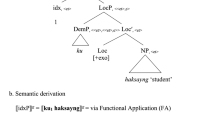




















































 that she bought last month ] already broke down.
that she bought last month ] already broke down.




































































 ; M
; M  ; š [ʃ]; y [j]; acute accents over vowels represent stressed syllables.
; š [ʃ]; y [j]; acute accents over vowels represent stressed syllables.


